BIOL 310 Practical 2 MUSCLES OIAI
1/247
There's no tags or description
Looks like no tags are added yet.
Name | Mastery | Learn | Test | Matching | Spaced |
|---|
No study sessions yet.
248 Terms
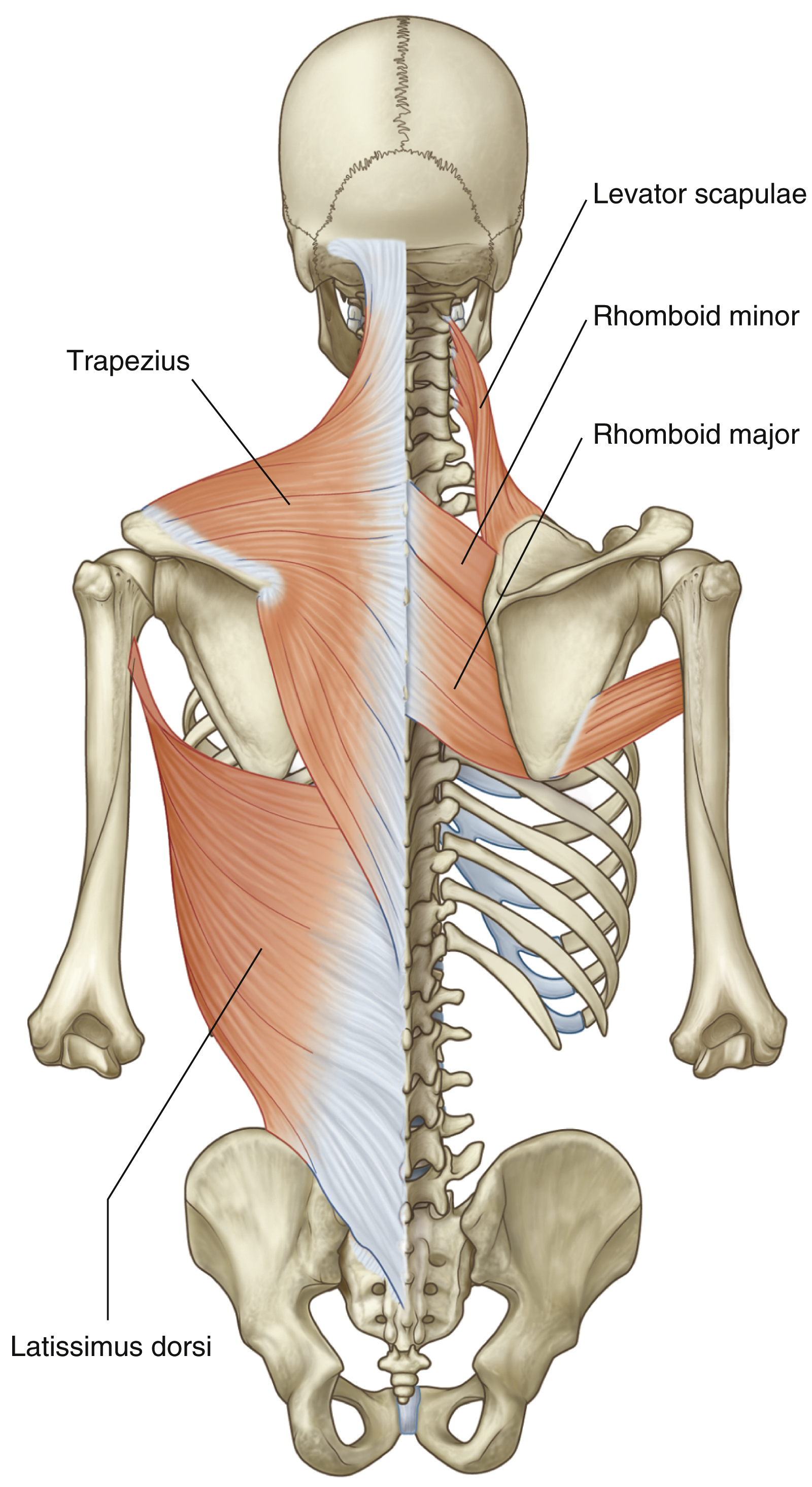
Trapezius: origin
Superior nuchal line, external occipital protuberance, medial margin of the ligamentum nuchae, spinous processes of CVII to TXII and the related supraspinous ligaments
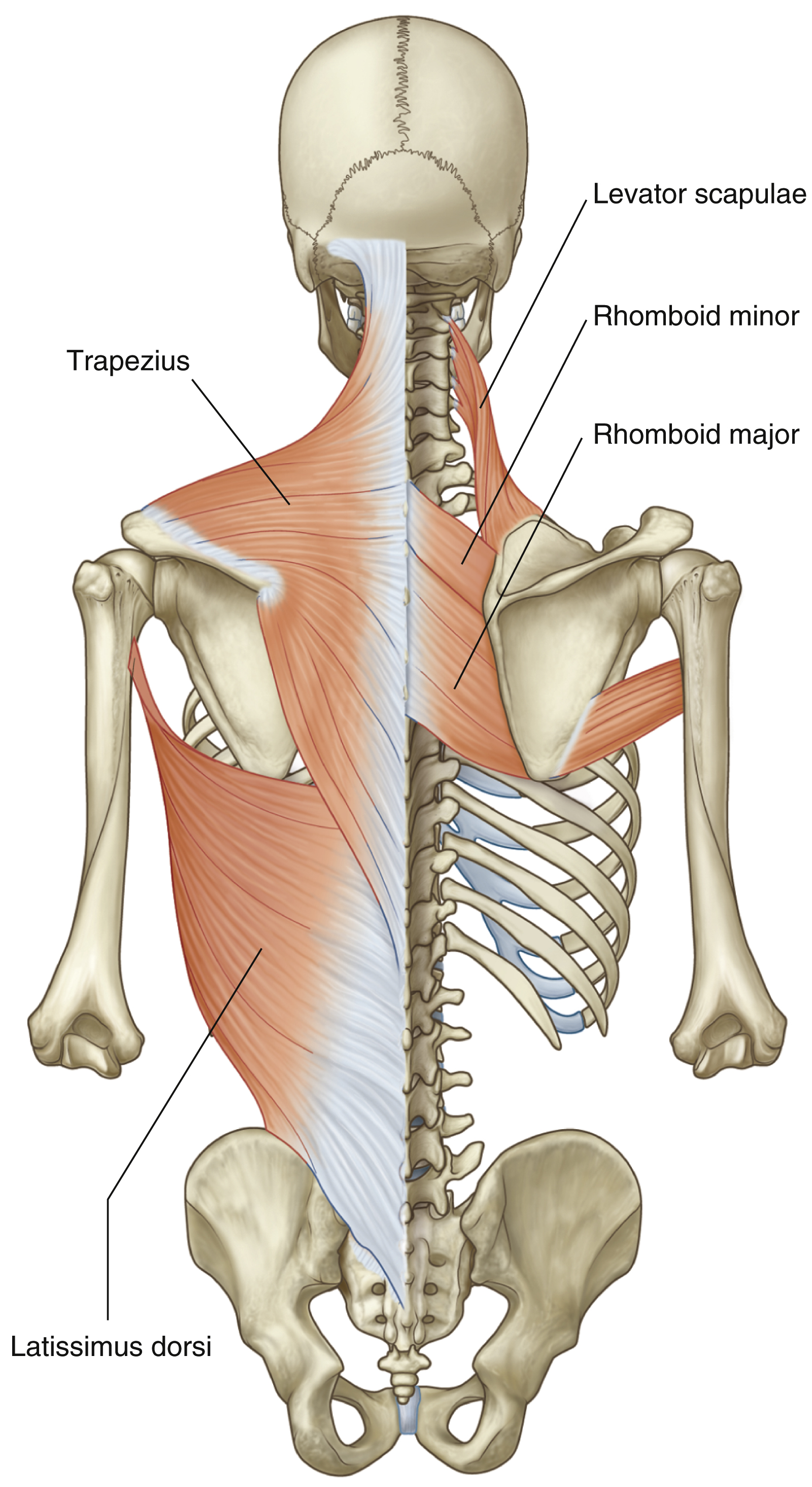
Trapezius: insertion
Superior edge of the crest of the spine of the scapula, acromion, posterior border of lateral one-third of clavicle
Trapezius: action
Powerful elevator of the scapula; rotates the scapula during abduction of humerus above horizontal; middle fibers retract scapula; lower fibers depress scapula
Trapezius: innervation
Motor—Accessory nerve (cranial nerve [XI]). Sensory—(proprioception) anterior rami of C3 and C4

Latissimus dorsi: origin
Spinous processes of lower six thoracic vertebrae and related interspinous ligaments; via the thoracolumbar fascia to the spinous processes of the lumbar vertebrae, related interspinous ligaments, and iliac crest; lower 3–4 ribs
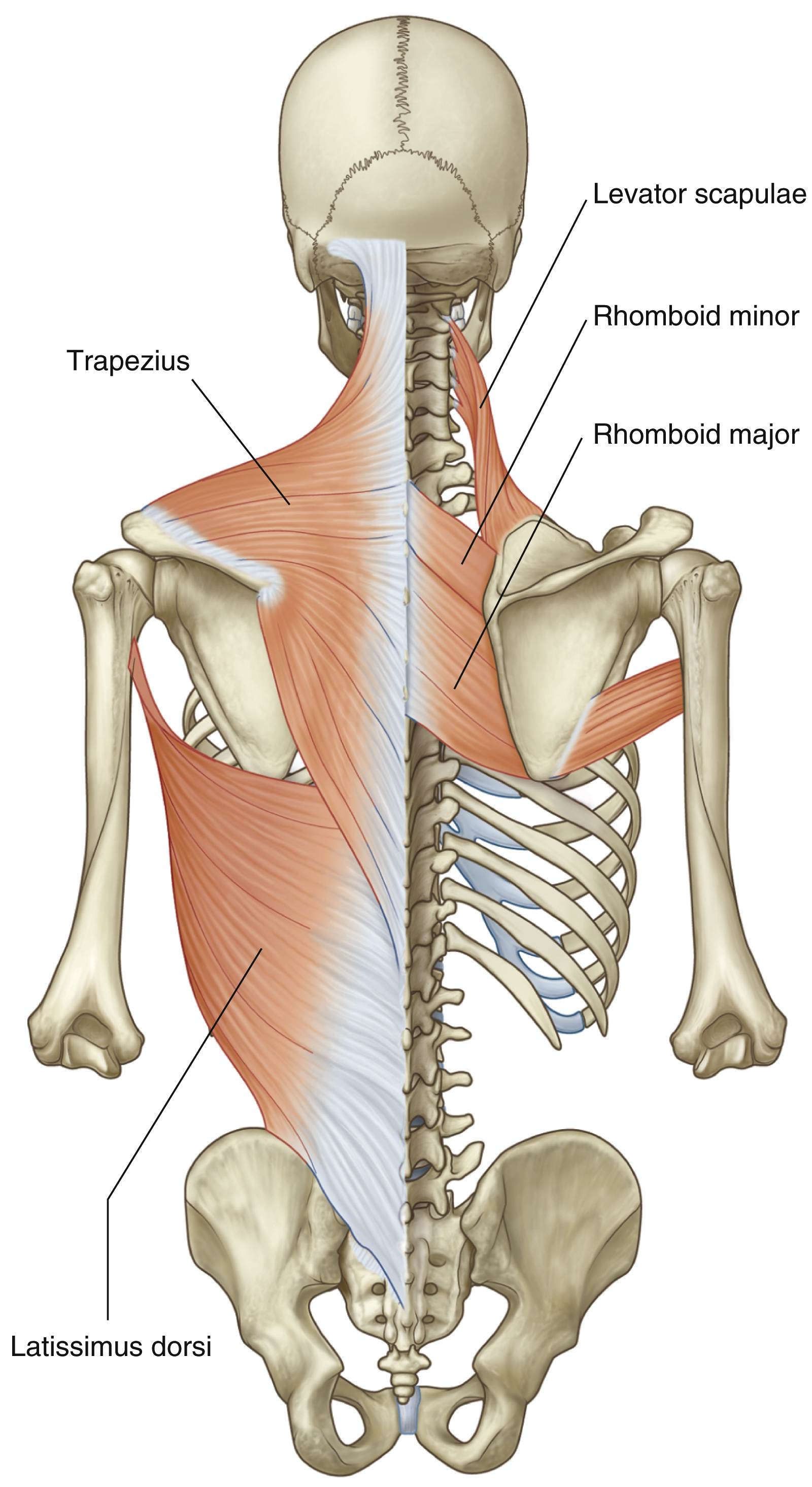
Latissimus dorsi: insertion
Floor of intertubercular sulcus
Latissimus dorsi: innervation
Thoracodorsal nerve (C6, C7 , C8)
Latissimus dorsi: action
Adduction, medial rotation, and extension of the arm at the glenohumeral joint
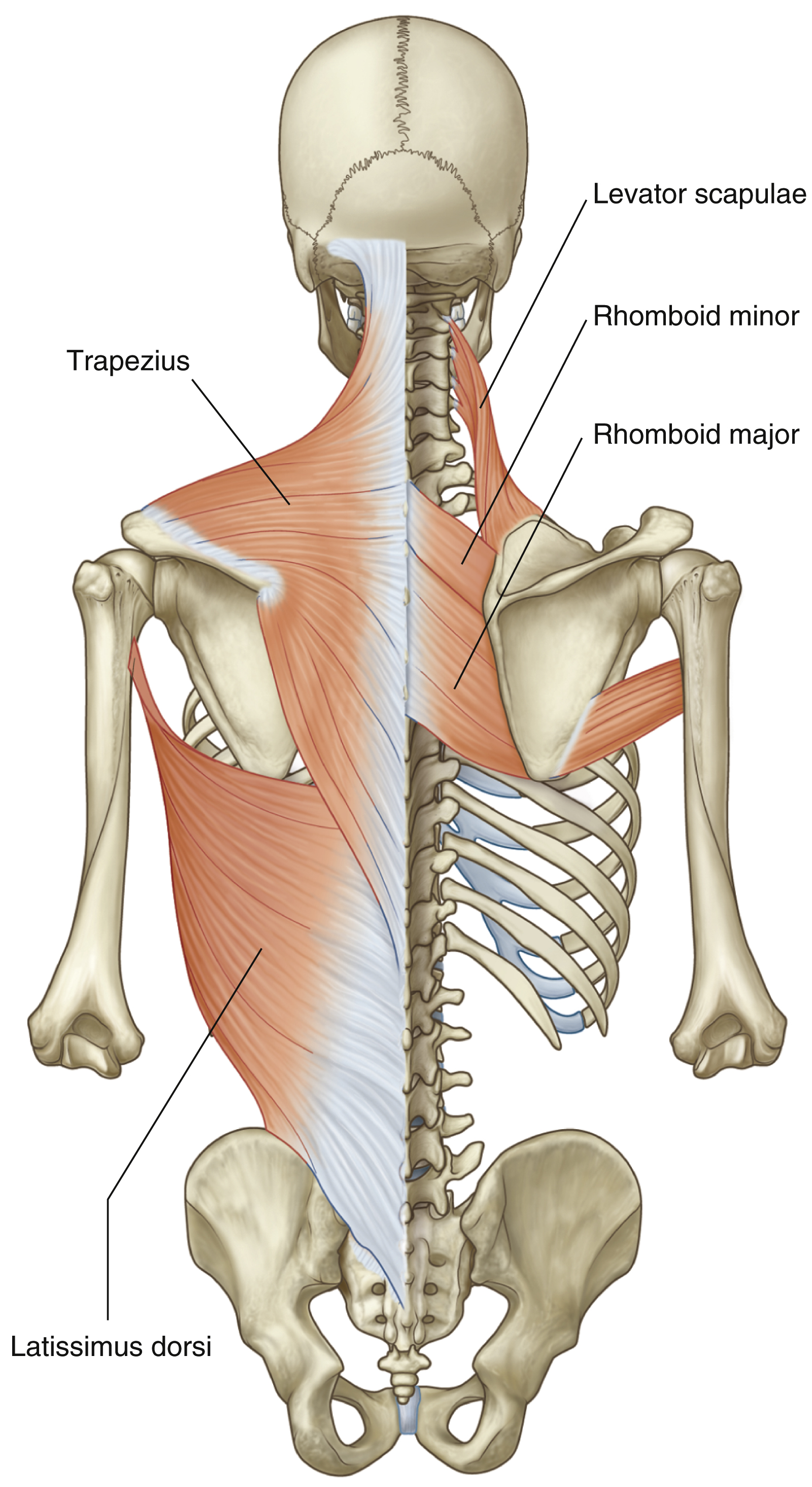
Levator scapulae: origin
Transverse processes of CI and CII vertebrae and posterior tubercles of transverse processes of CIII and CIV vertebrae
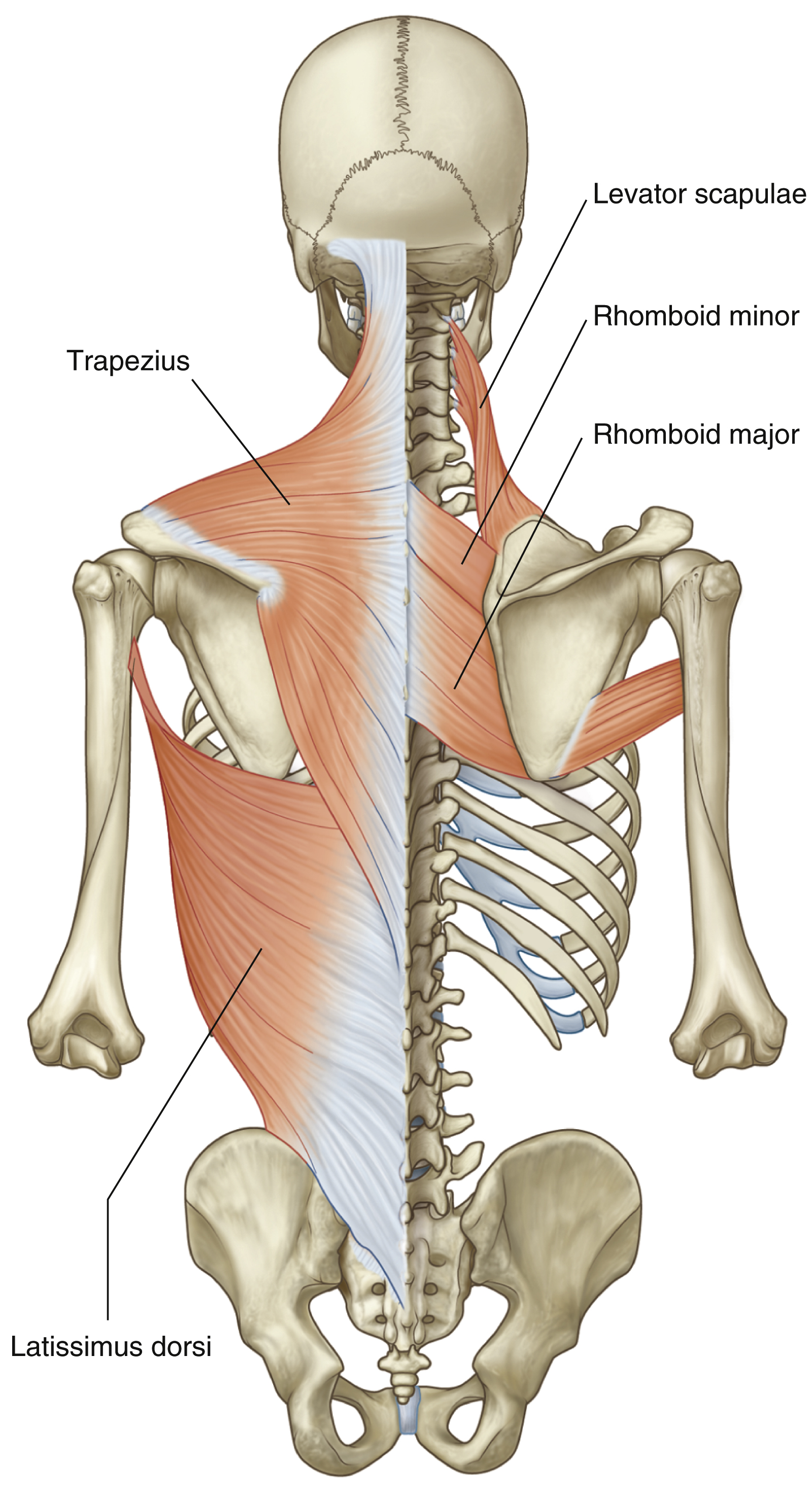
Levator scapulae: insertion
Posterior surface of medial border of scapula from superior angle to root of spine of the scapula
Levator scapulae: action
Elevates the scapula
Levator scapulae: innervation
Branches directly from anterior rami of C3 and C4 spinal nerves and by branches ( C5 ) from the dorsal scapular nerve
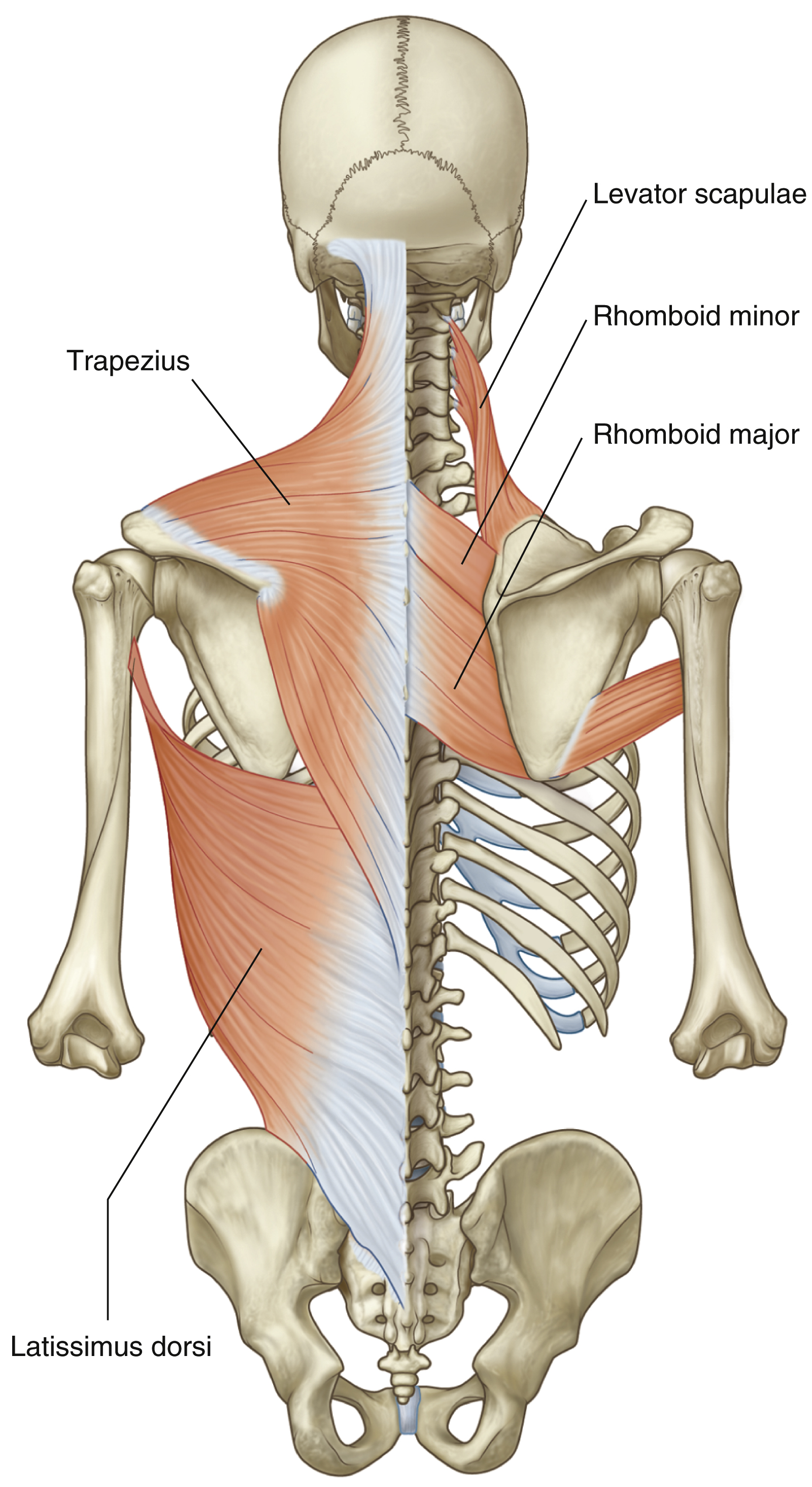
Rhomboids: origin
Lower end of ligamentum nuchae and spinous processes of CVII and TI vertebrae; Spinous processes of TII–TV vertebrae and intervening supraspinous ligaments
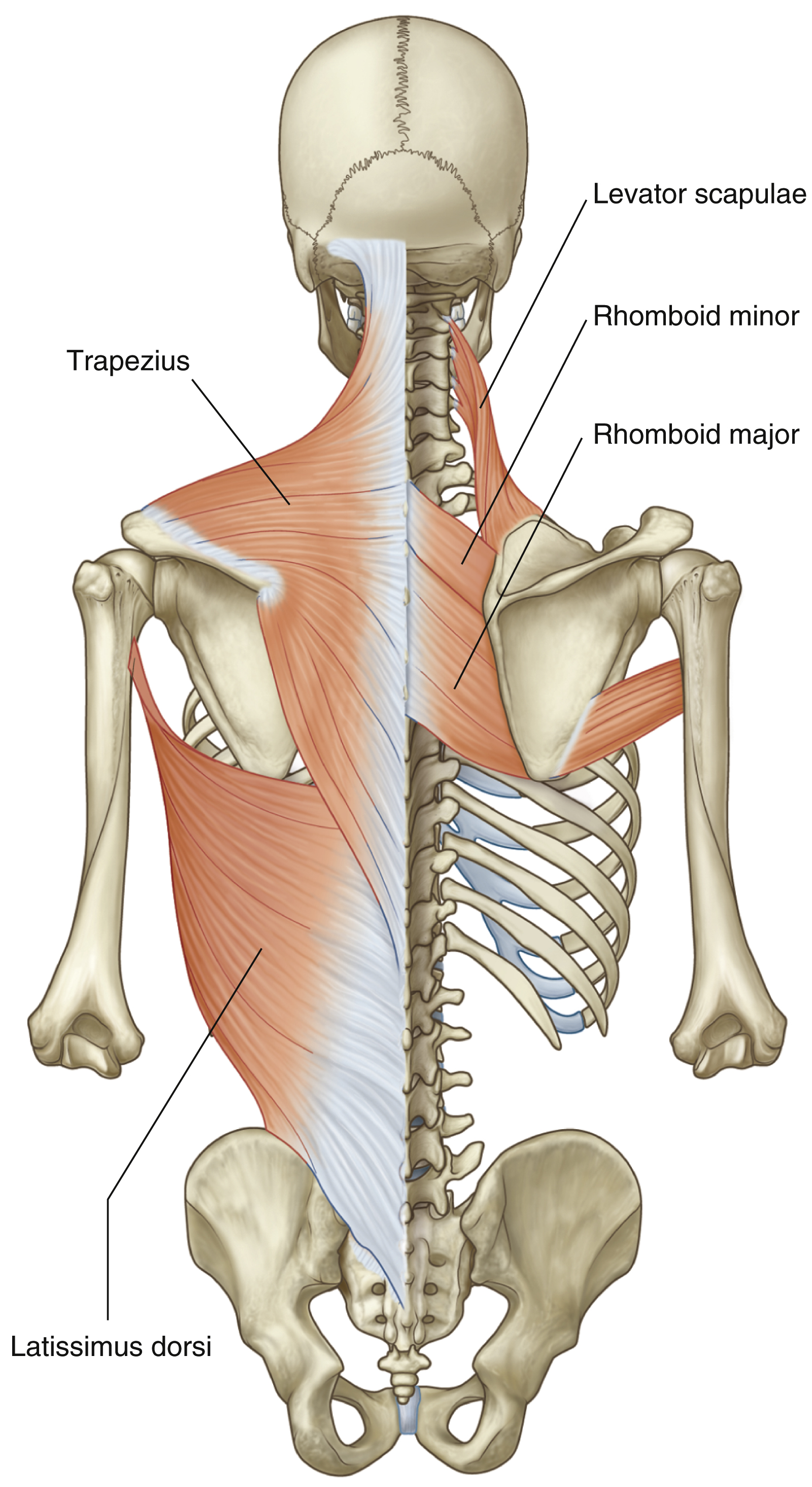
Rhomboids: insertion
Posterior surface of medial border of scapula from the root of the spine of the scapula to the inferior angle
Rhomboids: action
Elevates and retracts the scapula
Rhomboids: innervation
Dorsal scapular nerve ( C4, C5 )
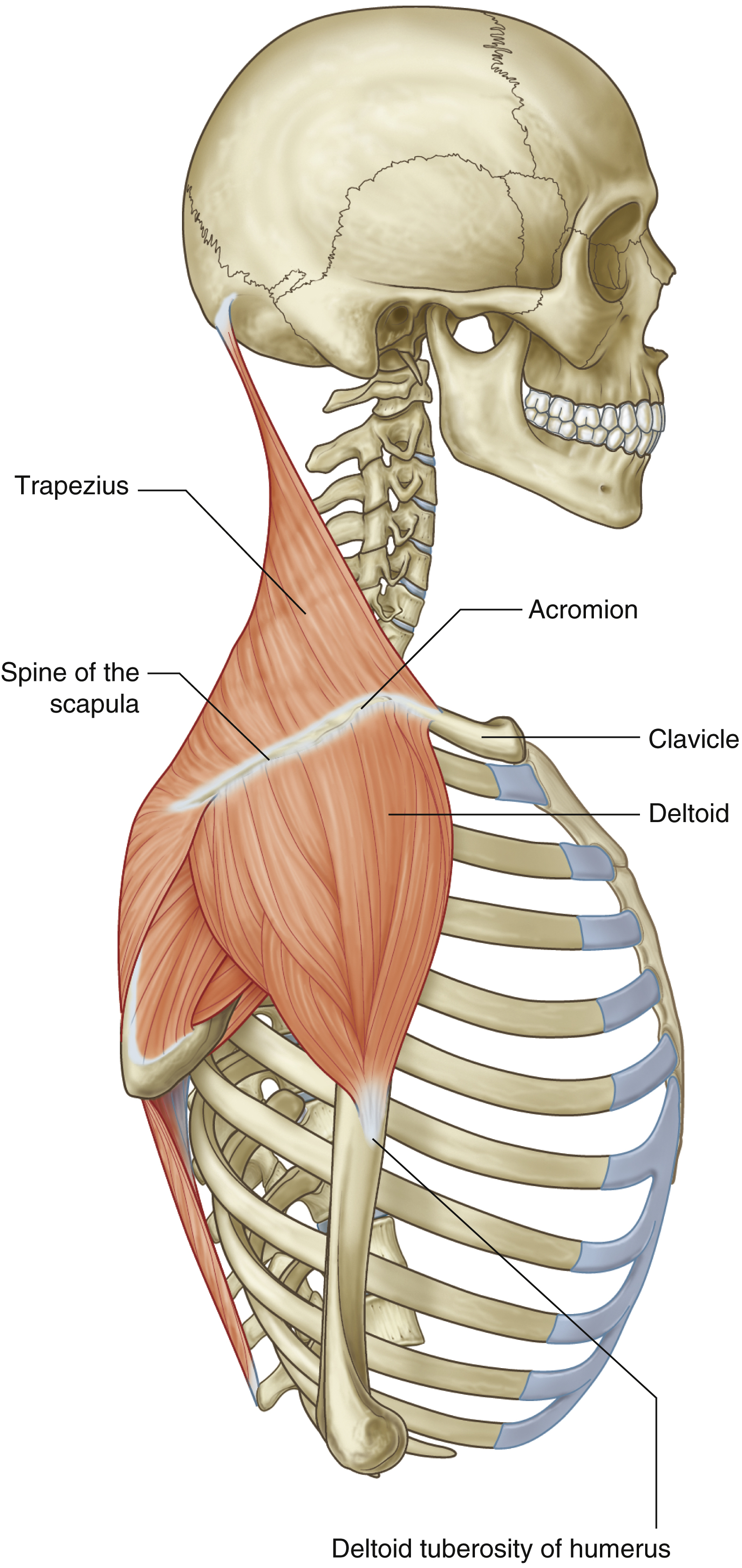
Deltoid: origin
Inferior edge of the crest of the spine of the scapula, lateral margin of the acromion, anterior border of lateral one-third of clavicle
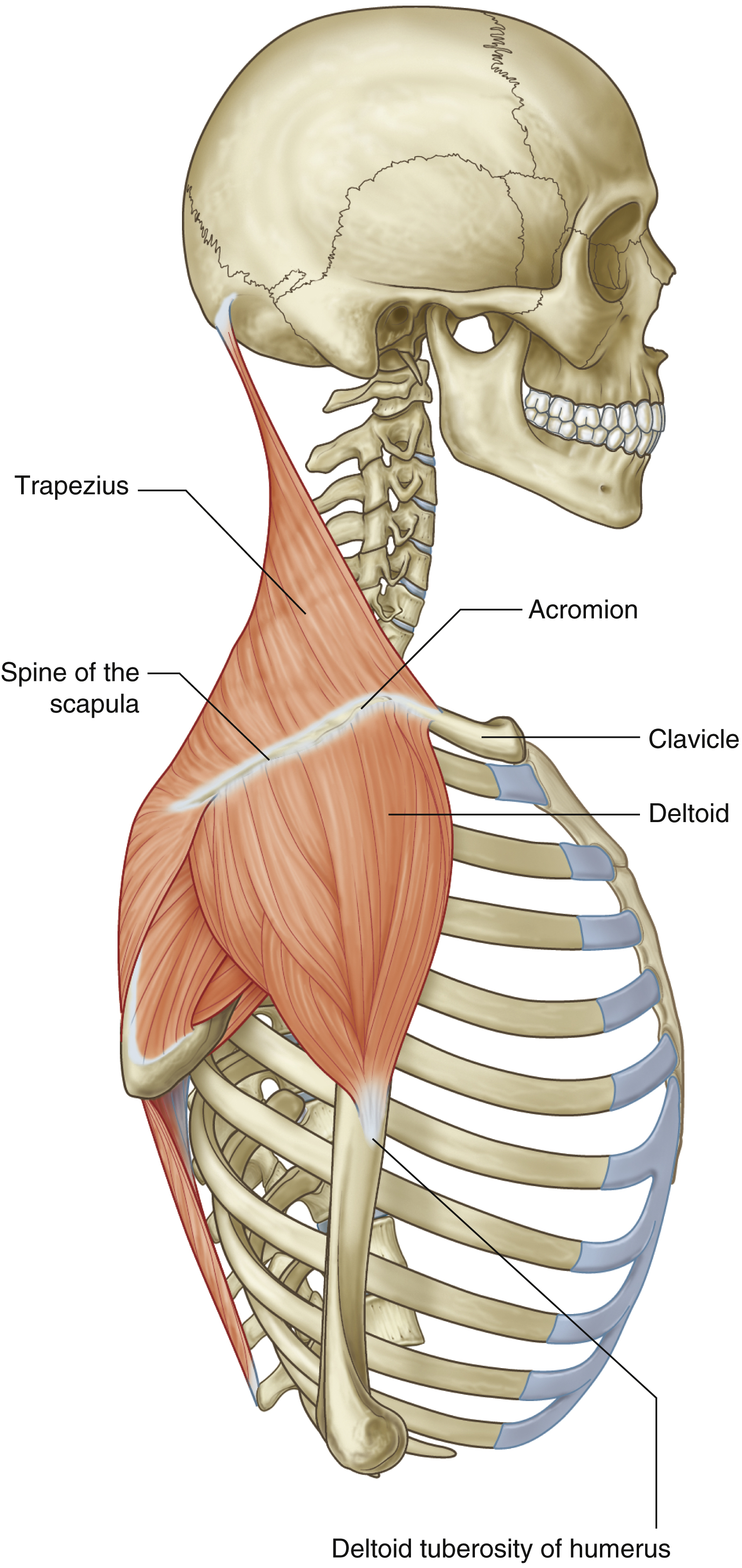
Deltoid: insertion
Deltoid tuberosity of humerus
Deltoid: action
Major abductor of arm; clavicular fibers assist in flexing the arm; posterior fibers assist in extending the arm
Deltoid: innervation
Axillary nerve ( C5 , C6)
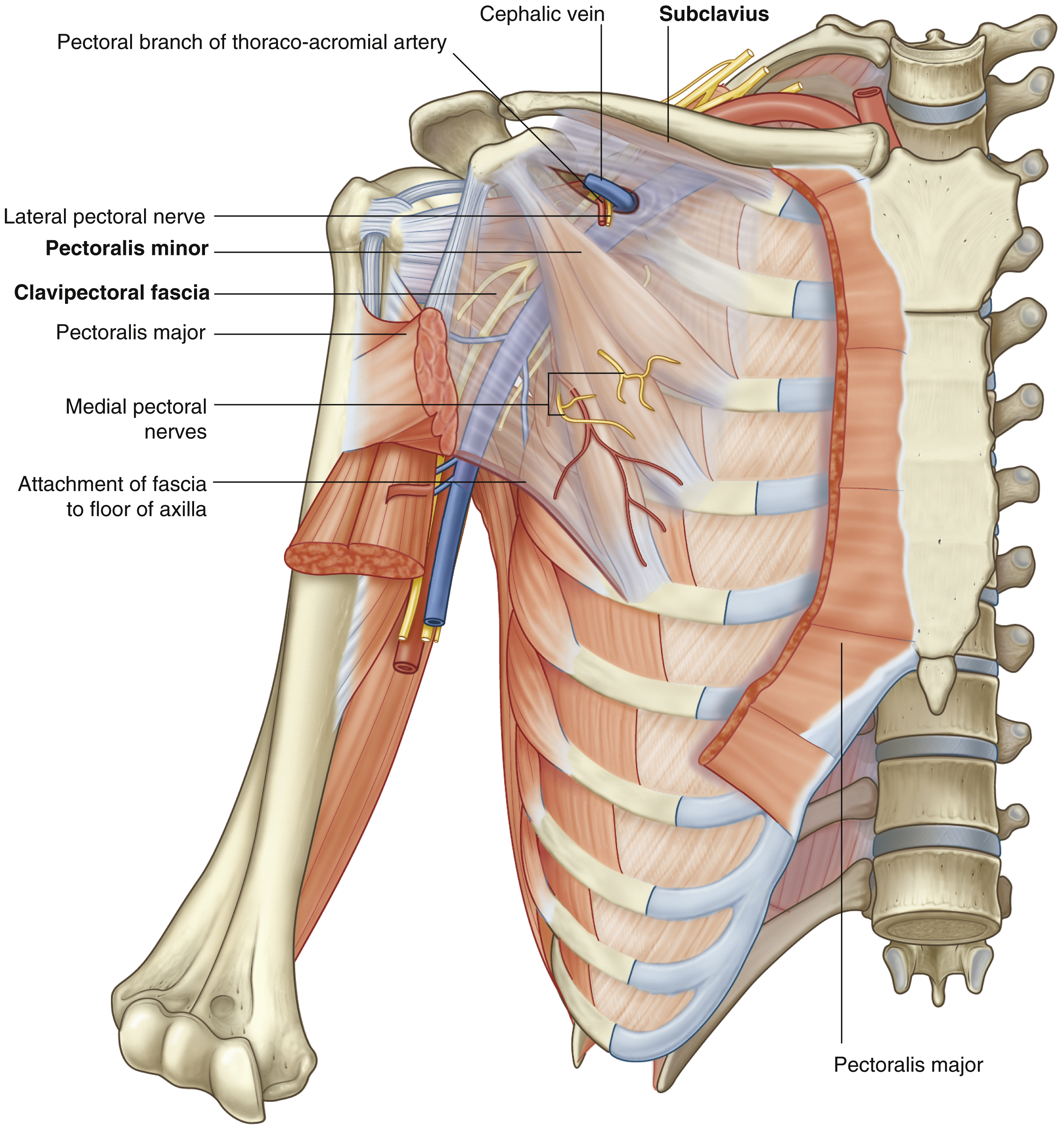
Pectoralis major: origin
Clavicular head—anterior surface of medial half of clavicle; sternocostal head—anterior surface of sternum; first seven costal cartilages; sternal end of sixth rib; aponeurosis of external oblique
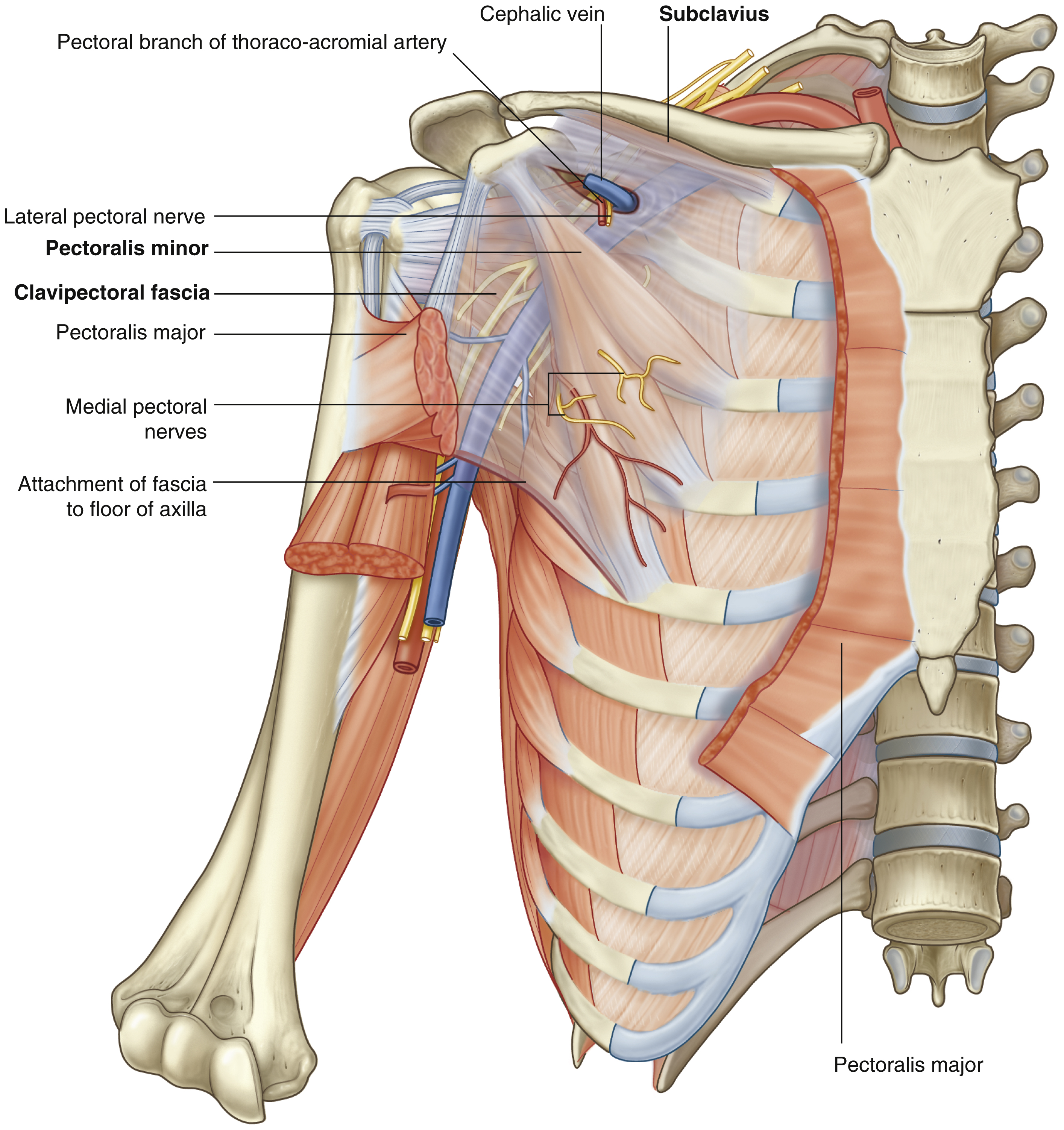
Pectoralis major: insertion
Lateral lip of intertubercular sulcus of humerus
Pectoralis major: action
Flexion, adduction, and medial rotation of arm at glenohumeral joint; clavicular head—flexion of extended arm; sternocostal head—extension of flexed arm
Pectoralis major: innervation
Medial and lateral pectoral nerves; clavicular head ( C5 , C6); sternocostal head (C6, C7 , C8, T1)
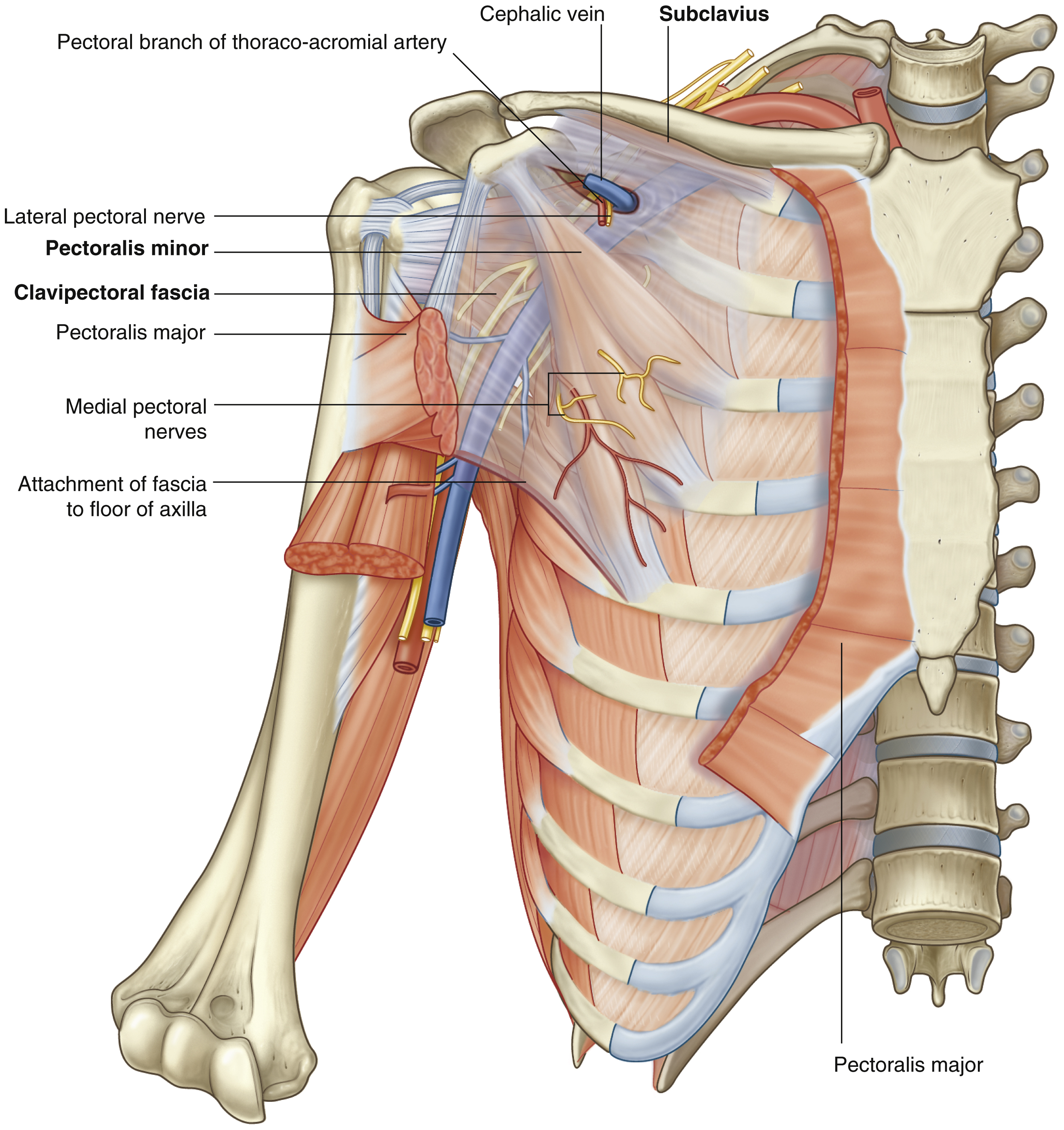
Pectoralis minor: origin
Anterior surfaces and superior borders of ribs III to V; and from deep fascia overlying the related intercostal spaces
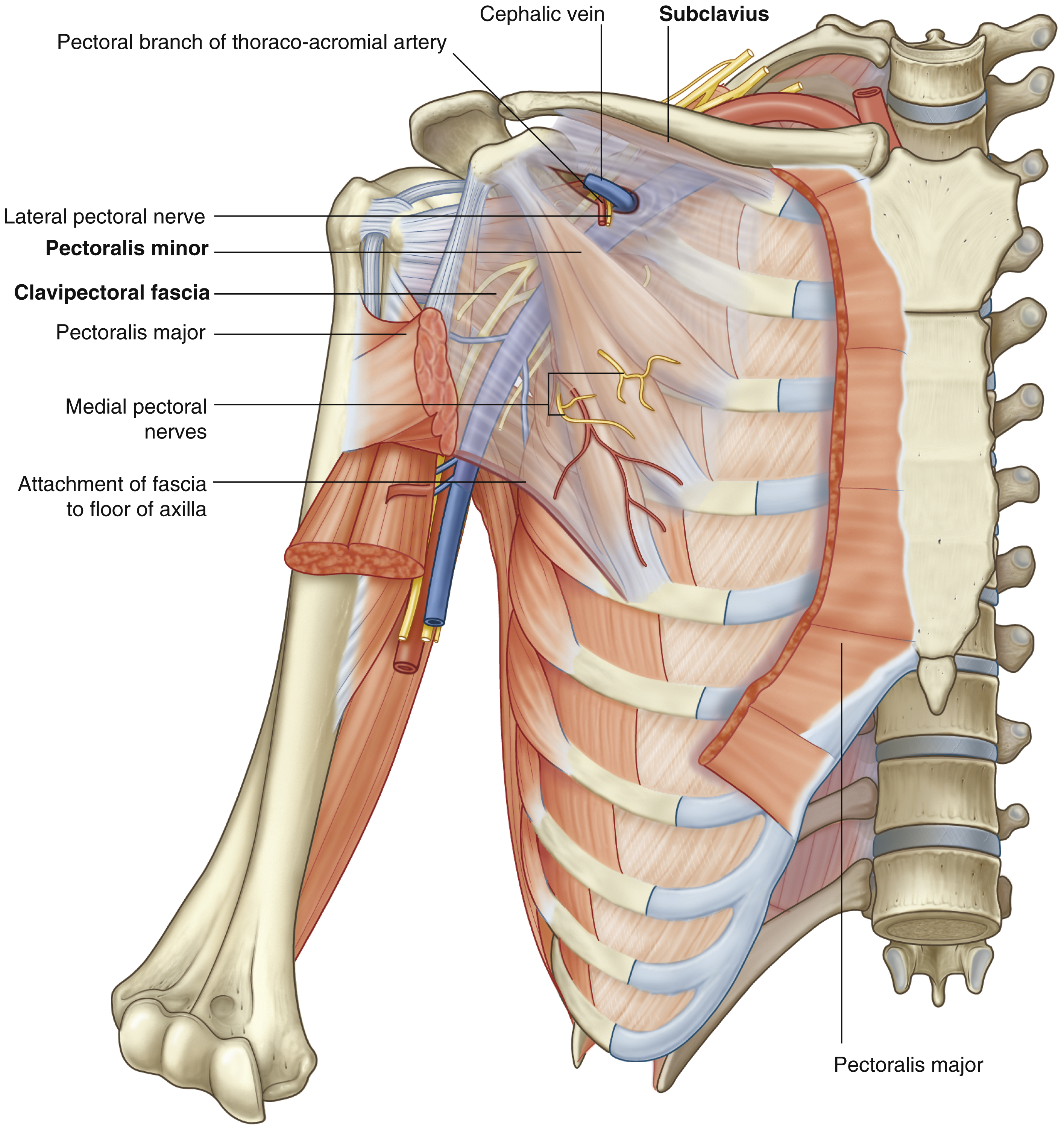
Pectoralis minor: insertion
Coracoid process of scapula (medial border and upper surface)
Pectoralis minor: action
Pulls tip of shoulder down; protracts scapula
Pectoralis minor: innervation
Medial and lateral pectoral nerve (C5, C6, C7, C8 , T1)
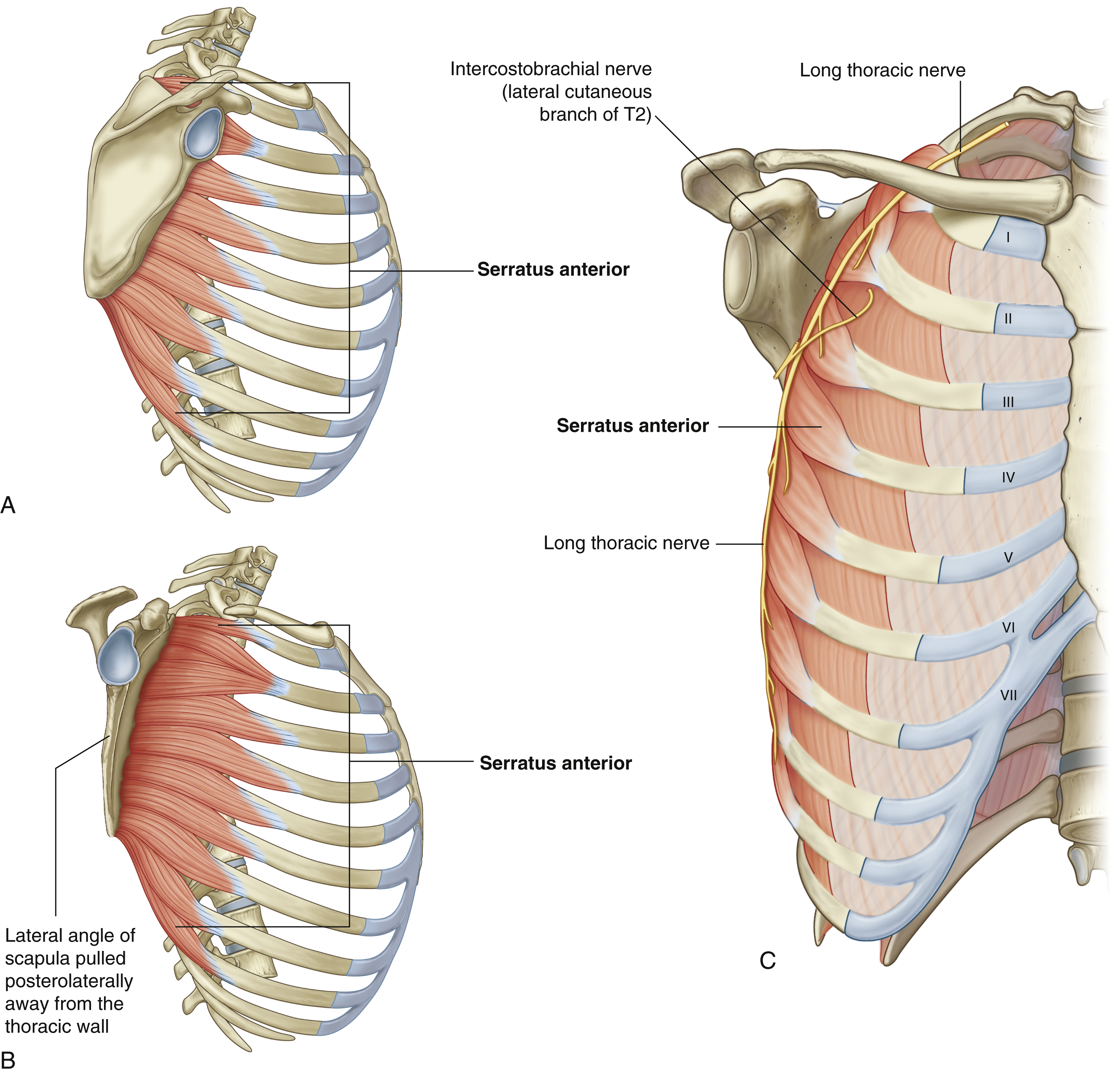
Serratus anterior: origin
Lateral surfaces of upper 8–9 ribs and deep fascia overlying the related intercostal spaces
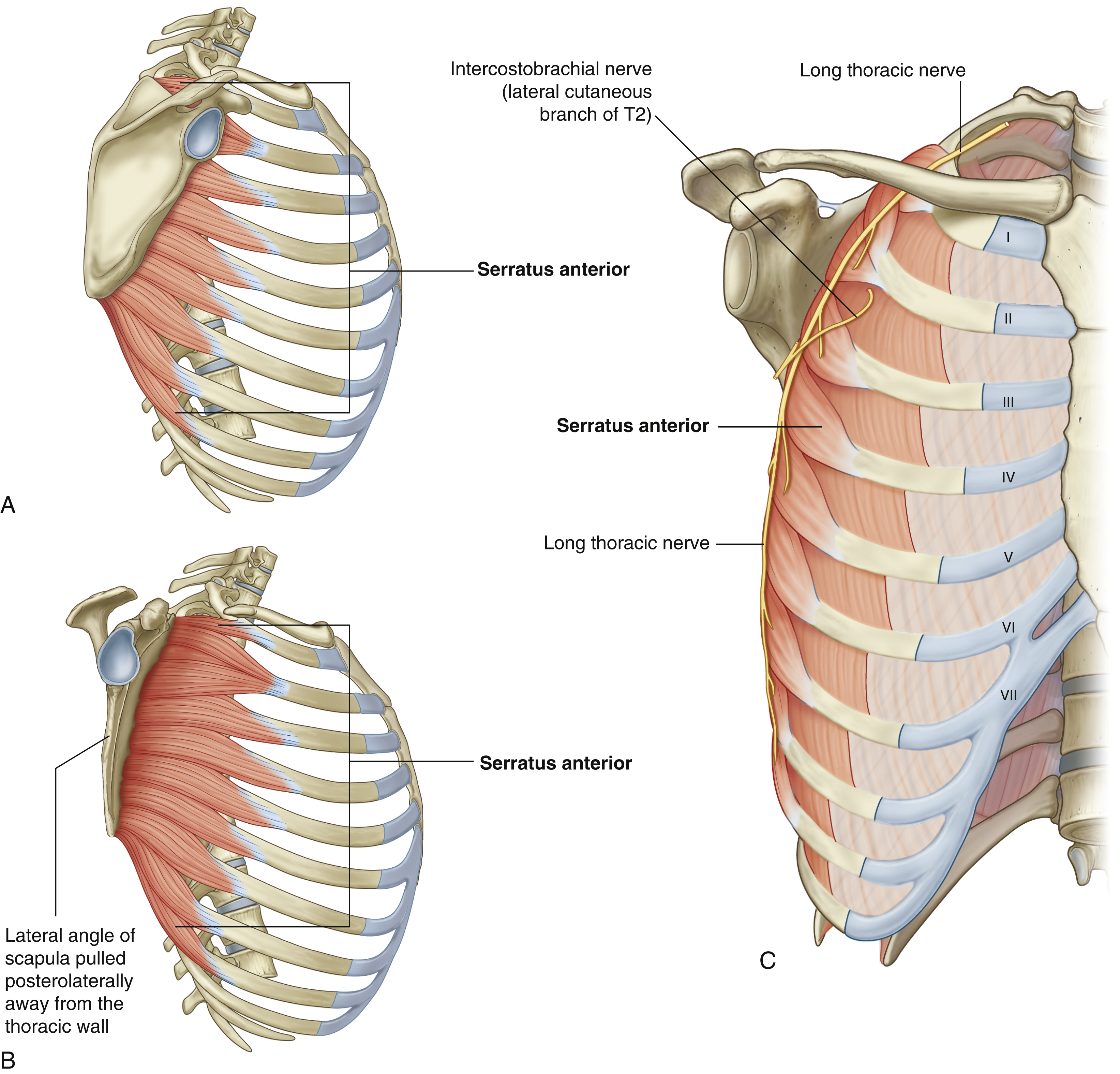
Serratus anterior: insertion
Costal surface of medial border of scapula
Serratus anterior: action
Protraction and rotation of the scapula; keeps medial border and inferior angle of scapula opposed to thoracic wall
Serratus anterior: innervation
Long thoracic nerve ( C5 , C6, C7)
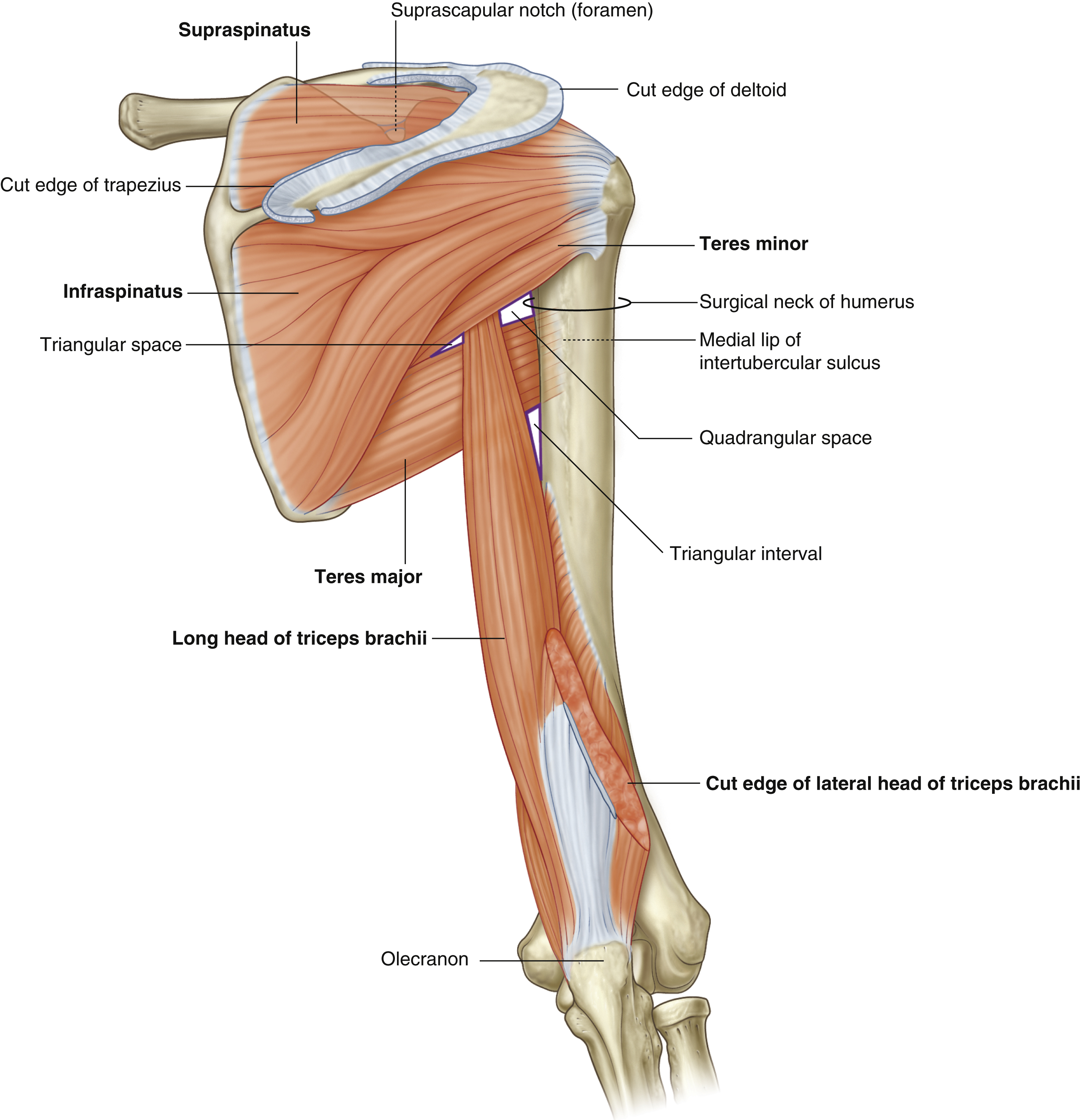
Supraspinatus: origin
Medial two-thirds of the supraspinous fossa of the scapula and the deep fascia that covers the muscle
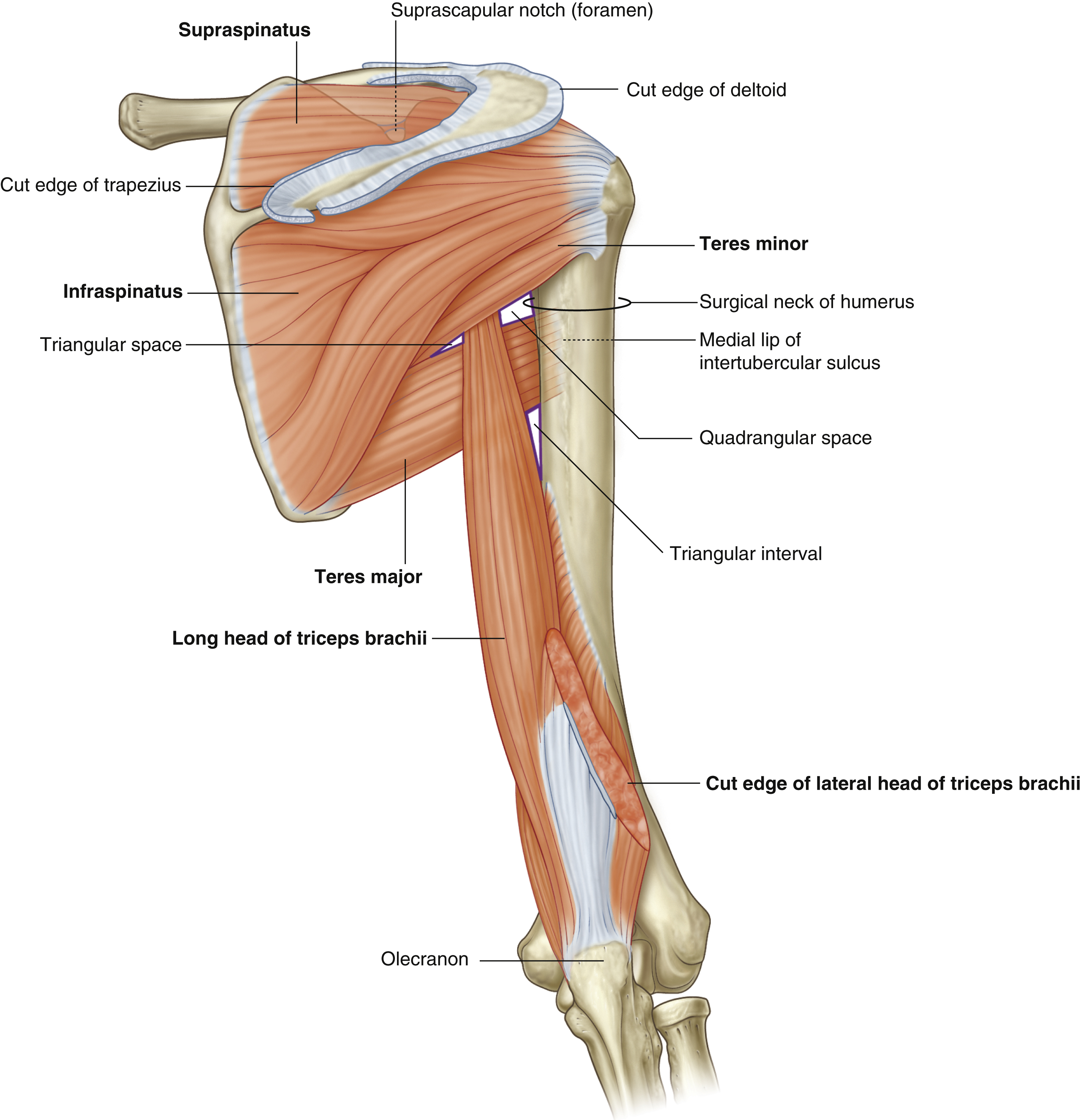
Supraspinatus: insertion
Most superior facet on the greater tubercle of the humerus
Supraspinatus: action
Rotator cuff muscle ; participates in abduction of the glenohumeral joint; stabilization of glenohumeral joint
Supraspinatus: innervation
Suprascapular nerve ( C5 , C6)

Infraspinatus: origin
Medial two-thirds of the infraspinous fossa of the scapula and the deep fascia that covers the muscle
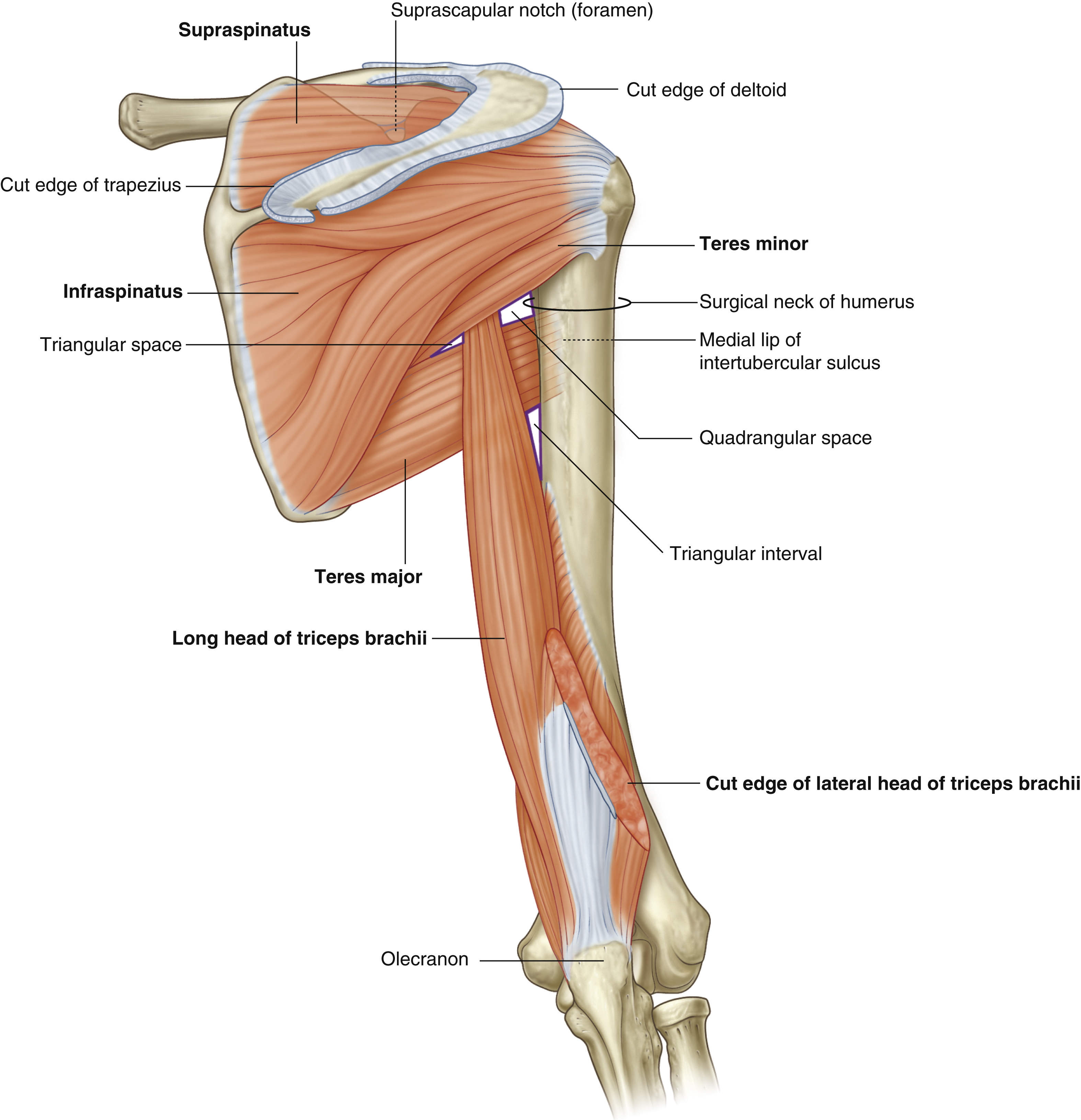
Infraspinatus: insertion
Middle facet on posterior surface of the greater tubercle of the humerus
Infraspinatus: action
Rotator cuff muscle ; lateral rotation of arm at the glenohumeral joint; stabilization of glenohumeral joint
Infraspinatus: innervation
Suprascapular nerve ( C5 , C6)
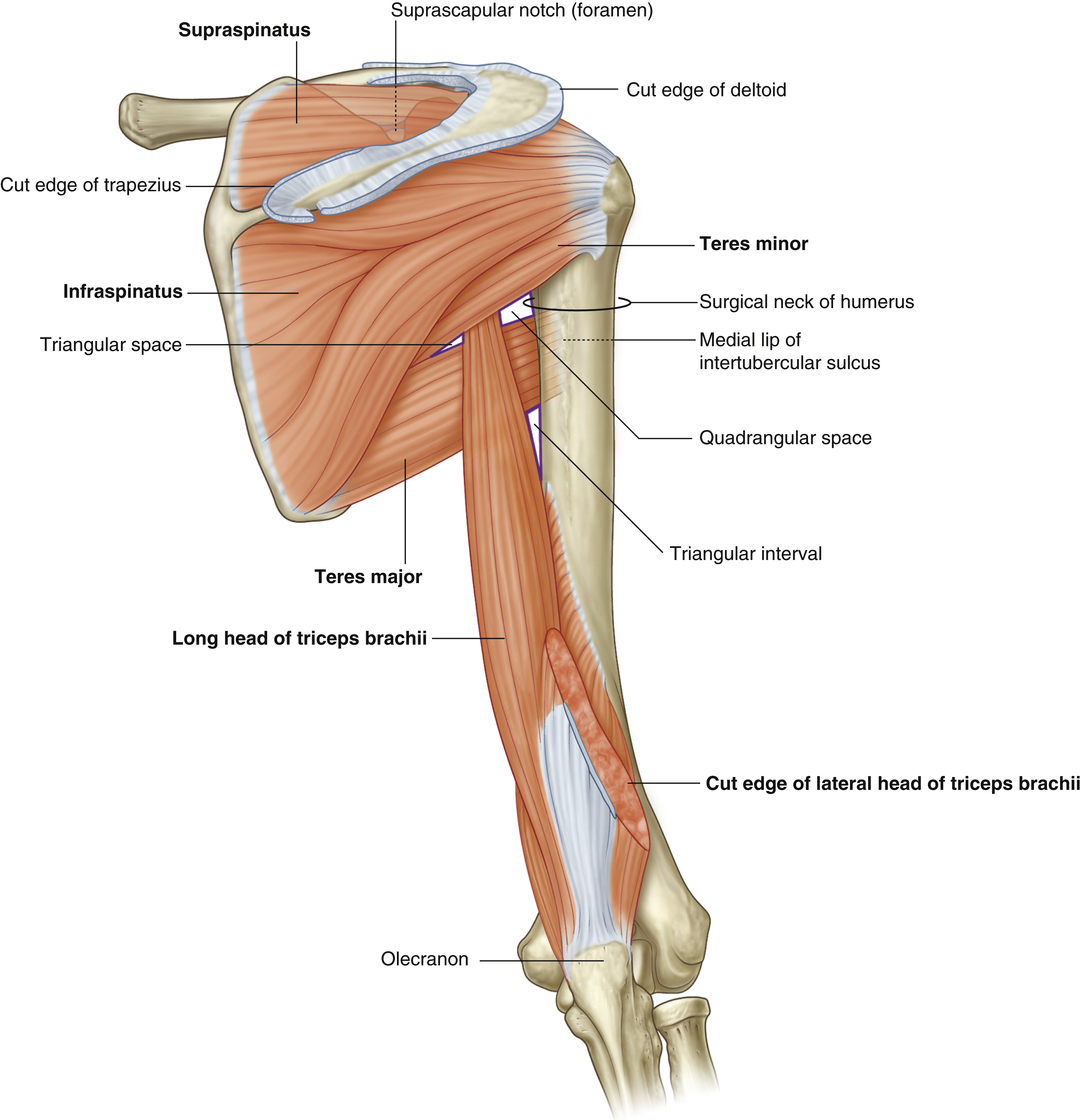
Teres minor: origin
Upper two-thirds of a flattened strip of bone on the posterior surface of the scapula immediately adjacent to the lateral border of the scapula
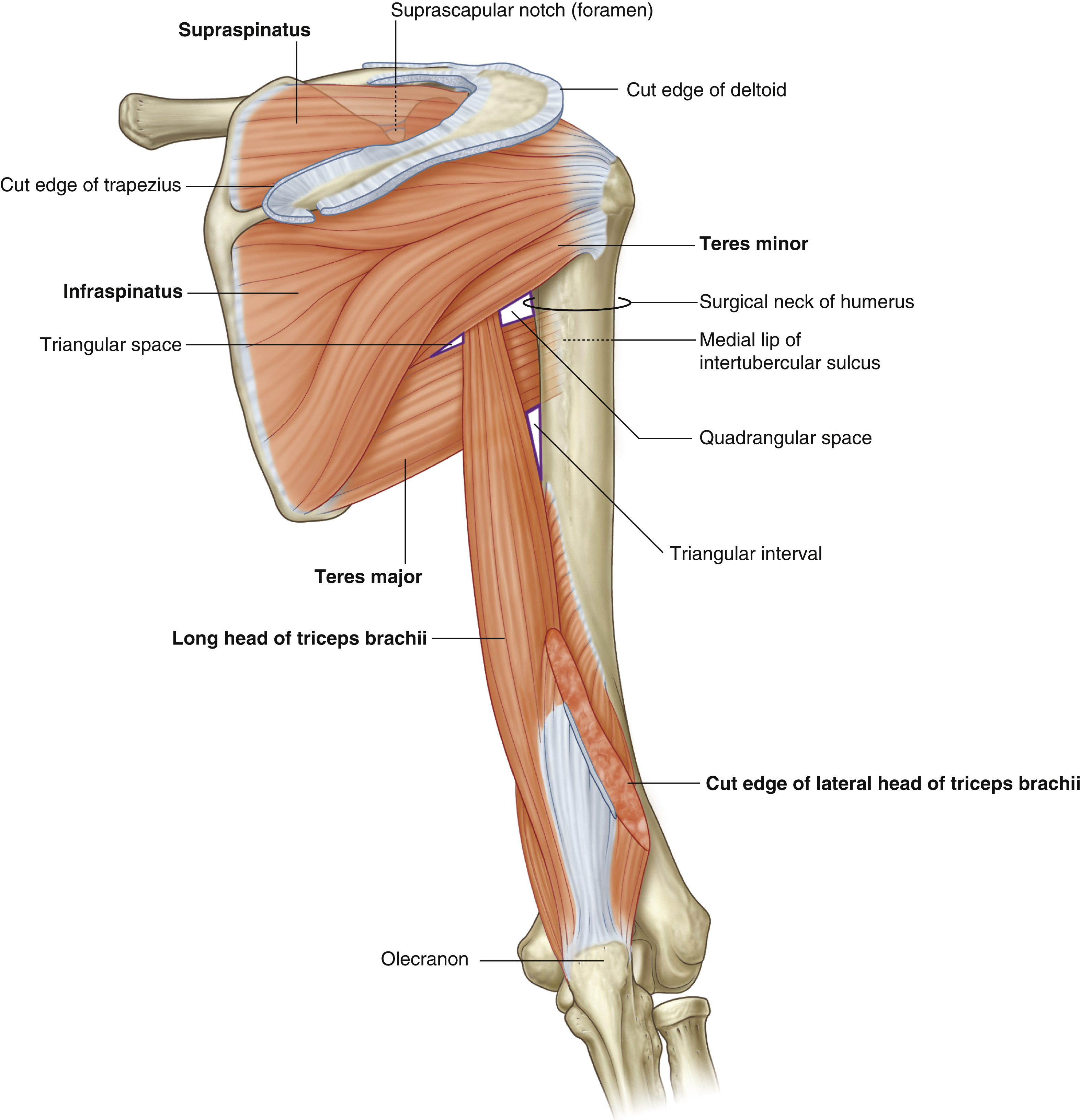
Teres minor: insertion
Inferior facet on the posterior surface of the greater tubercle of the humerus
Teres minor: action
Rotator cuff muscle ; lateral rotation of arm at the glenohumeral joint; stabilization of glenohumeral joint
Teres minor: innervation
Axillary nerve ( C5 , C6)
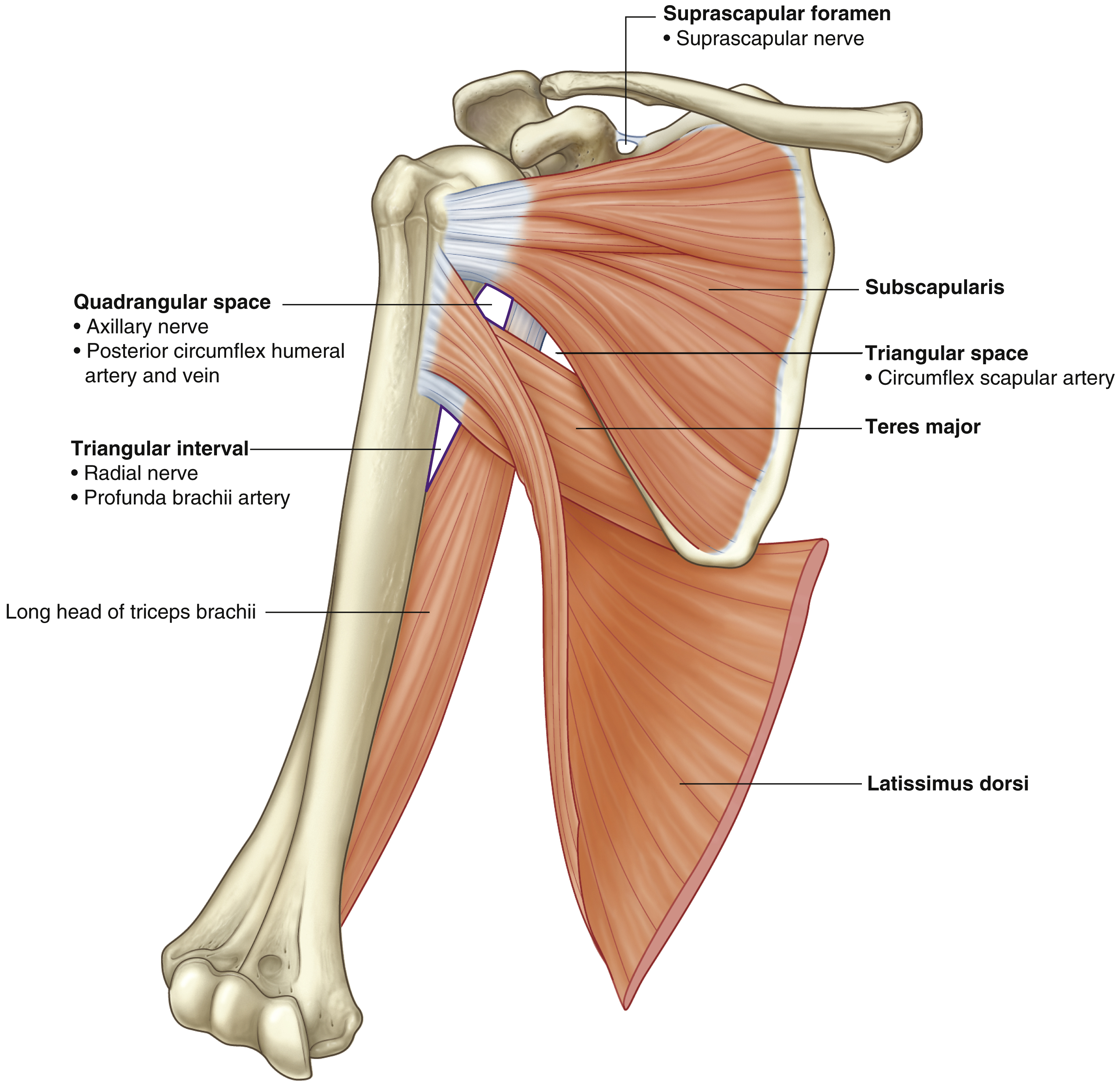
Subscapularis: origin
Medial two-thirds of subscapular fossa

Subscapularis: insertion
Lesser tubercle of humerus
Subscapularis: action
Rotator cuff muscle ; medial rotation of the arm at the glenohumeral joint
Subscapularis: innervation
Upper and lower subscapular nerves (C5, C6 , (C7))
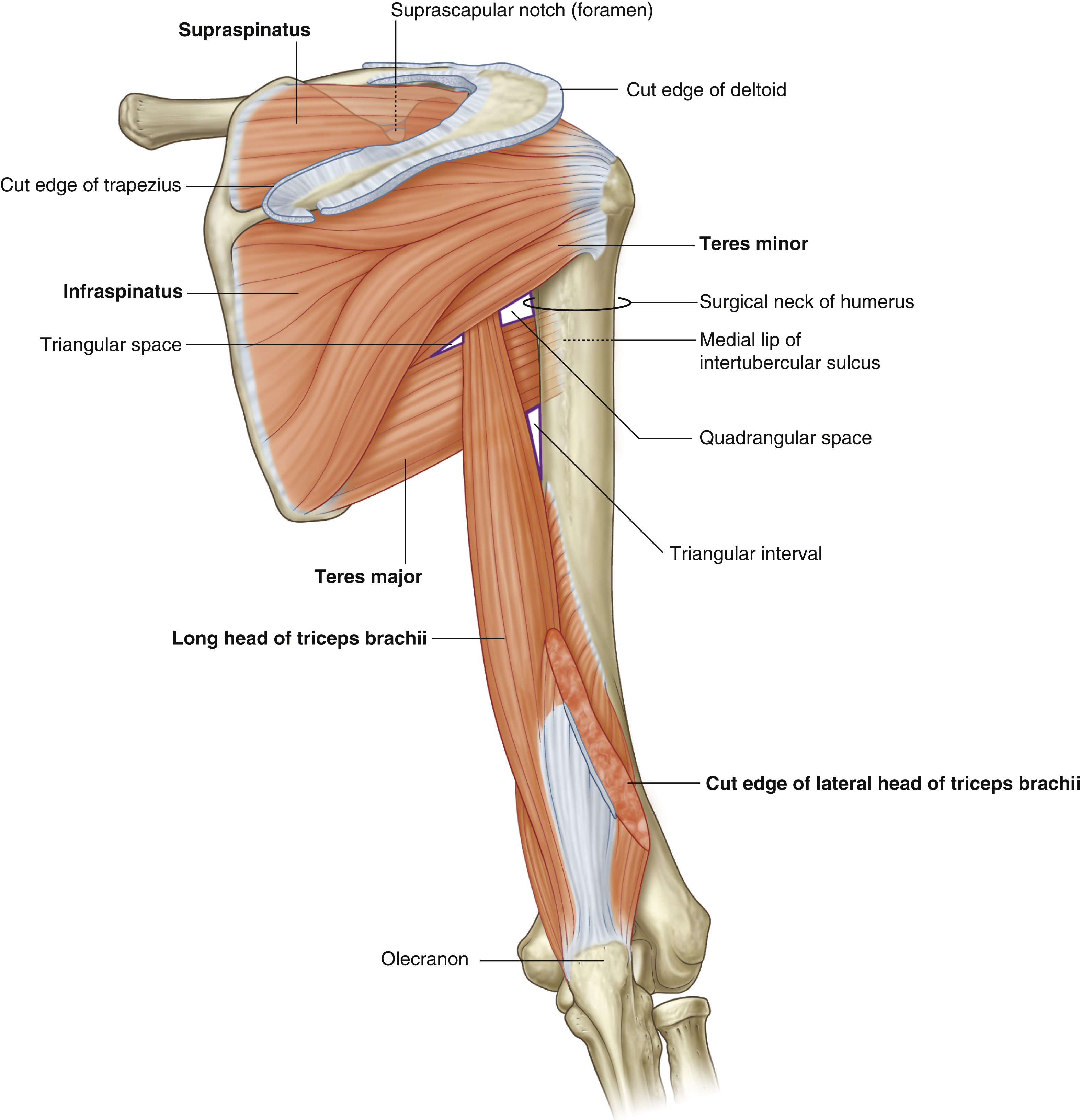
Teres major: origin
Elongate oval area on the posterior surface of the inferior angle of scapula

Teres major: insertion
Medial lip of the intertubercular sulcus on the anterior surface of the humerus
Teres major: action
Medial rotation and extension of the arm at the glenohumeral joint; stabilization of glenohumeral joint
Teres major: innervation
Inferior subscapular nerve ( C5, C6, C7 )
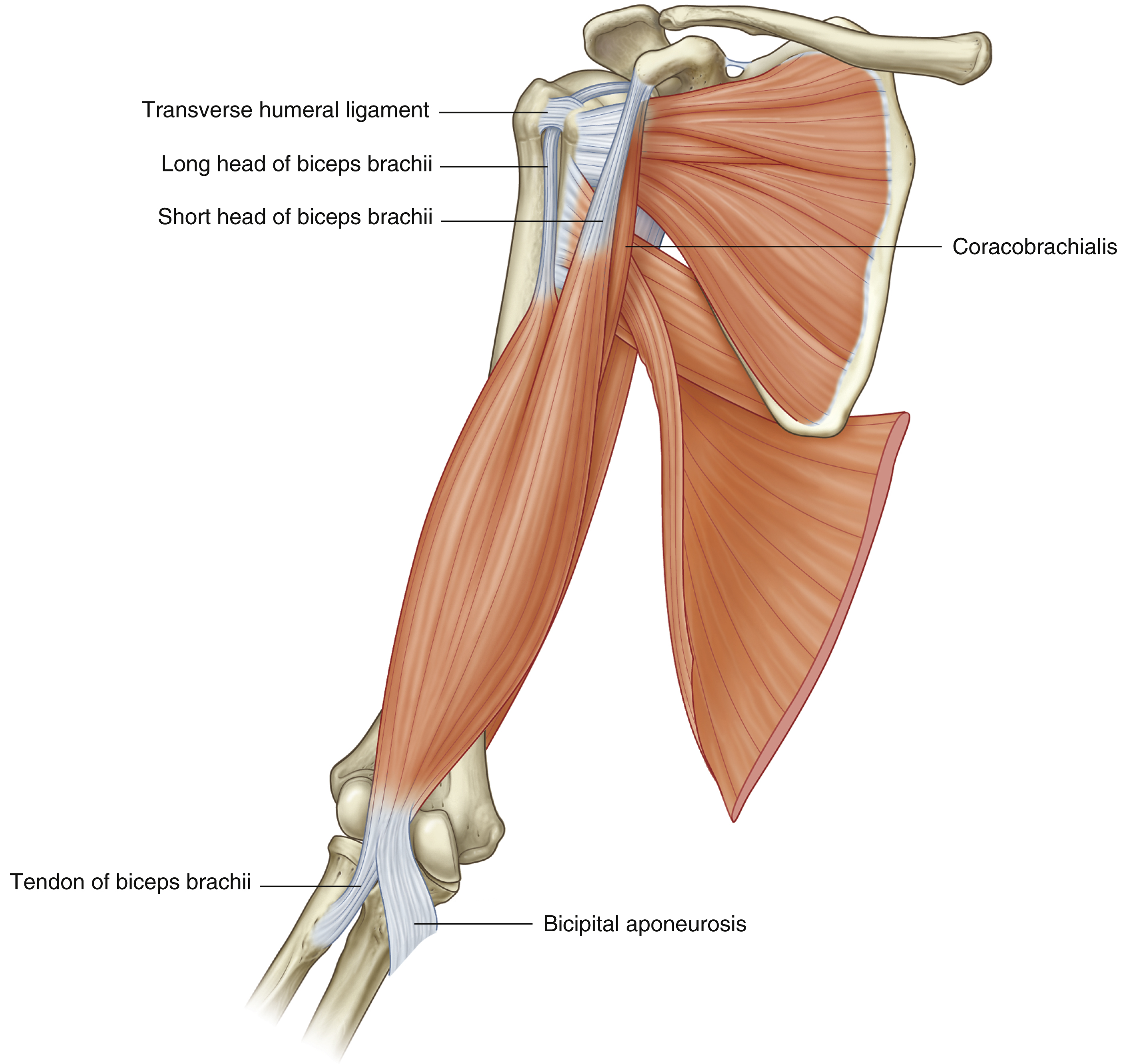
Biceps brachii: origin
Long head—supraglenoid tubercle of scapula; short head—apex of coracoid process

Biceps brachii: insertion
Tuberosity of radius
Biceps brachii: action
Powerful flexor of the forearm at the elbow joint and supinator of the forearm; accessory flexor of the arm at the glenohumeral joint
Biceps brachii: innervation
Musculocutaneous nerve ( C5, C6 )
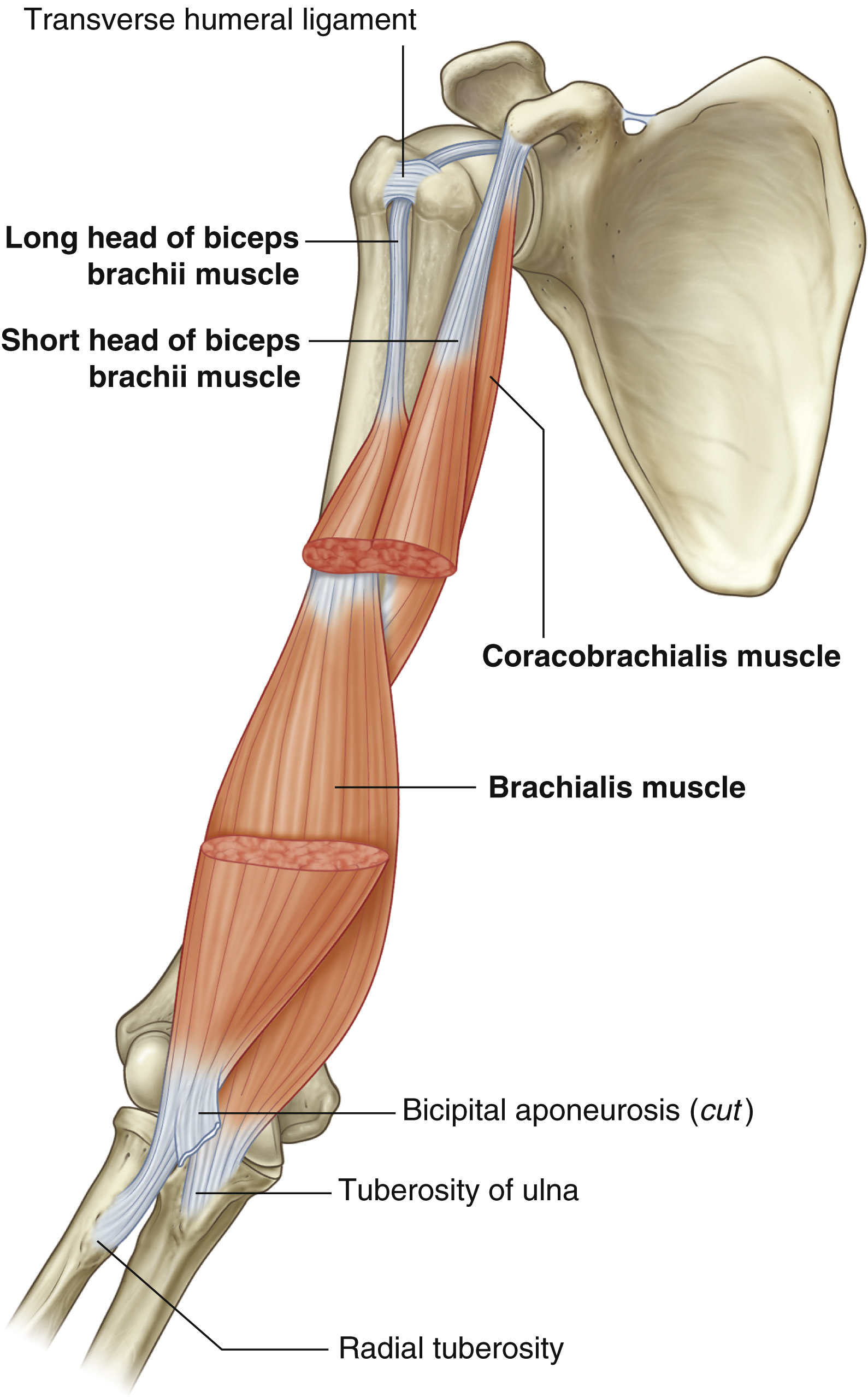
Coracobrachialis: origin
Apex of coracoid process
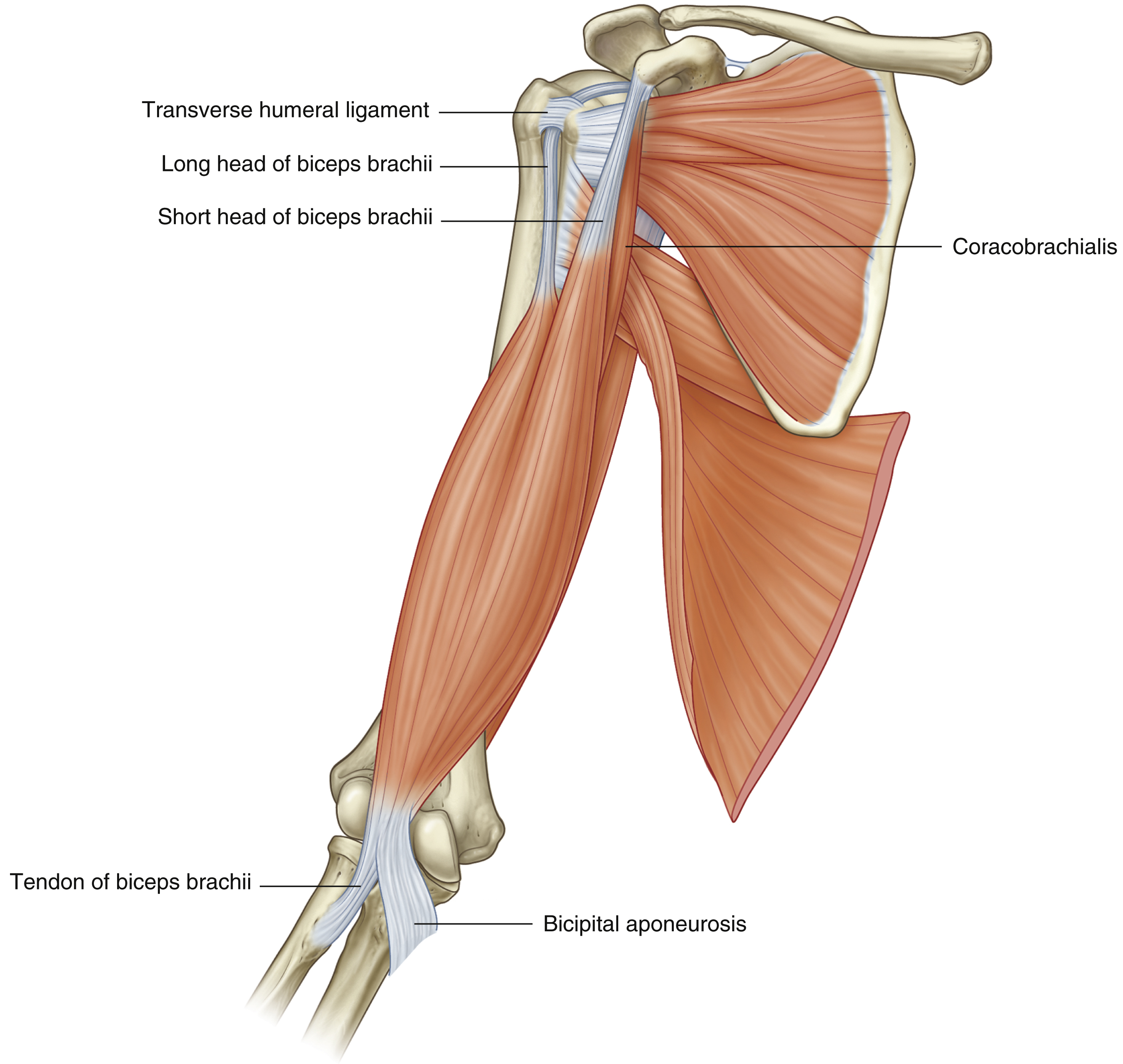
Coracobrachialis: insertion
Linear roughening on midshaft of humerus on medial side
Coracobrachialis: action
Flexor of the arm at the glenohumeral joint; adducts arm
Coracobrachialis: innervation
Musculocutaneous nerve ( C5, C6, C7 )
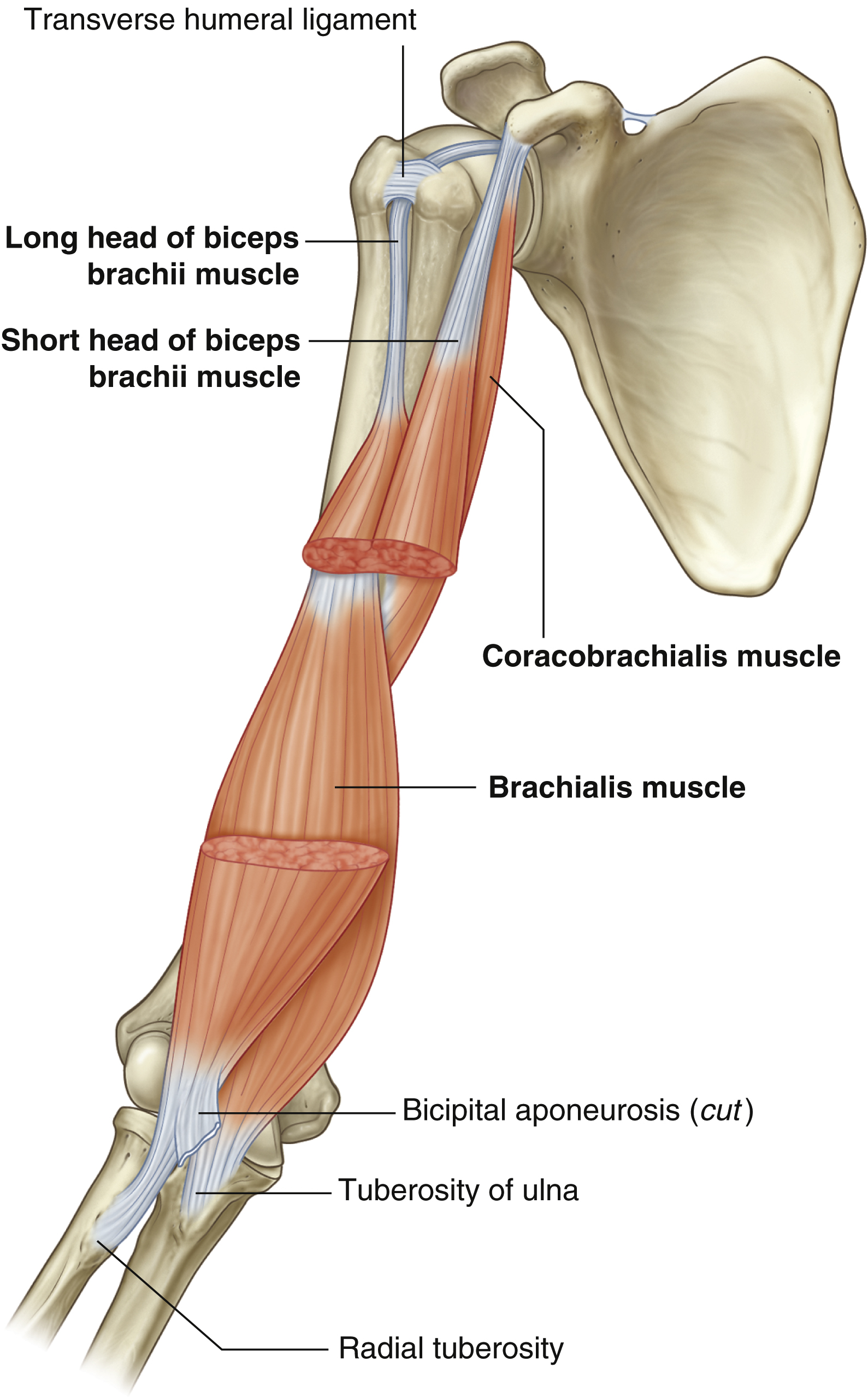
Brachialis: origin
Anterior aspect of humerus (medial and lateral surfaces) and adjacent intermuscular septae
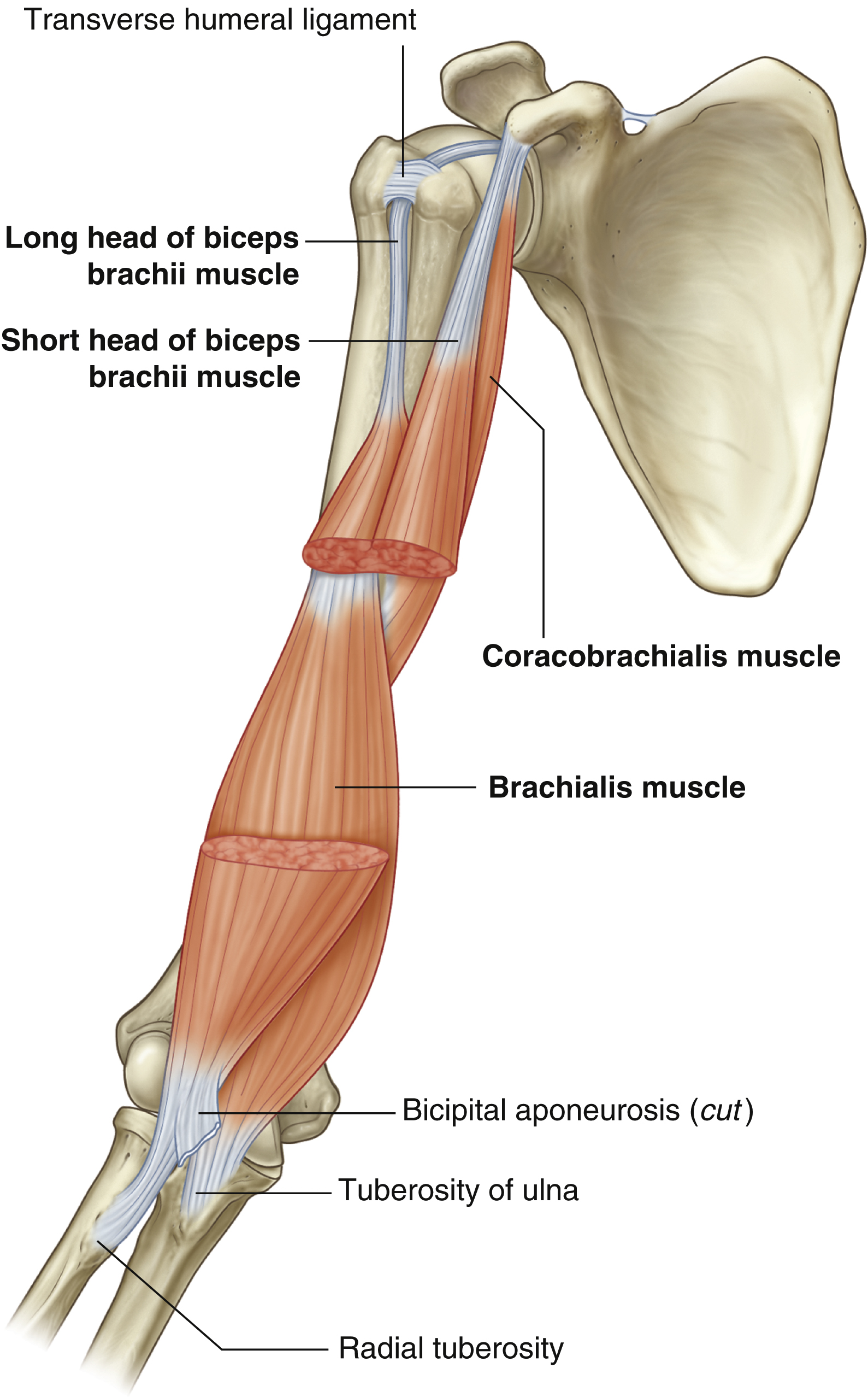
Brachialis: insertion
Tuberosity of the ulna
Brachialis: action
Powerful flexor of the forearm at the elbow joint
Brachialis: innervation
Musculocutaneous nerve (C5, C6 ); small contribution by the radial nerve (C7) to lateral part of muscle
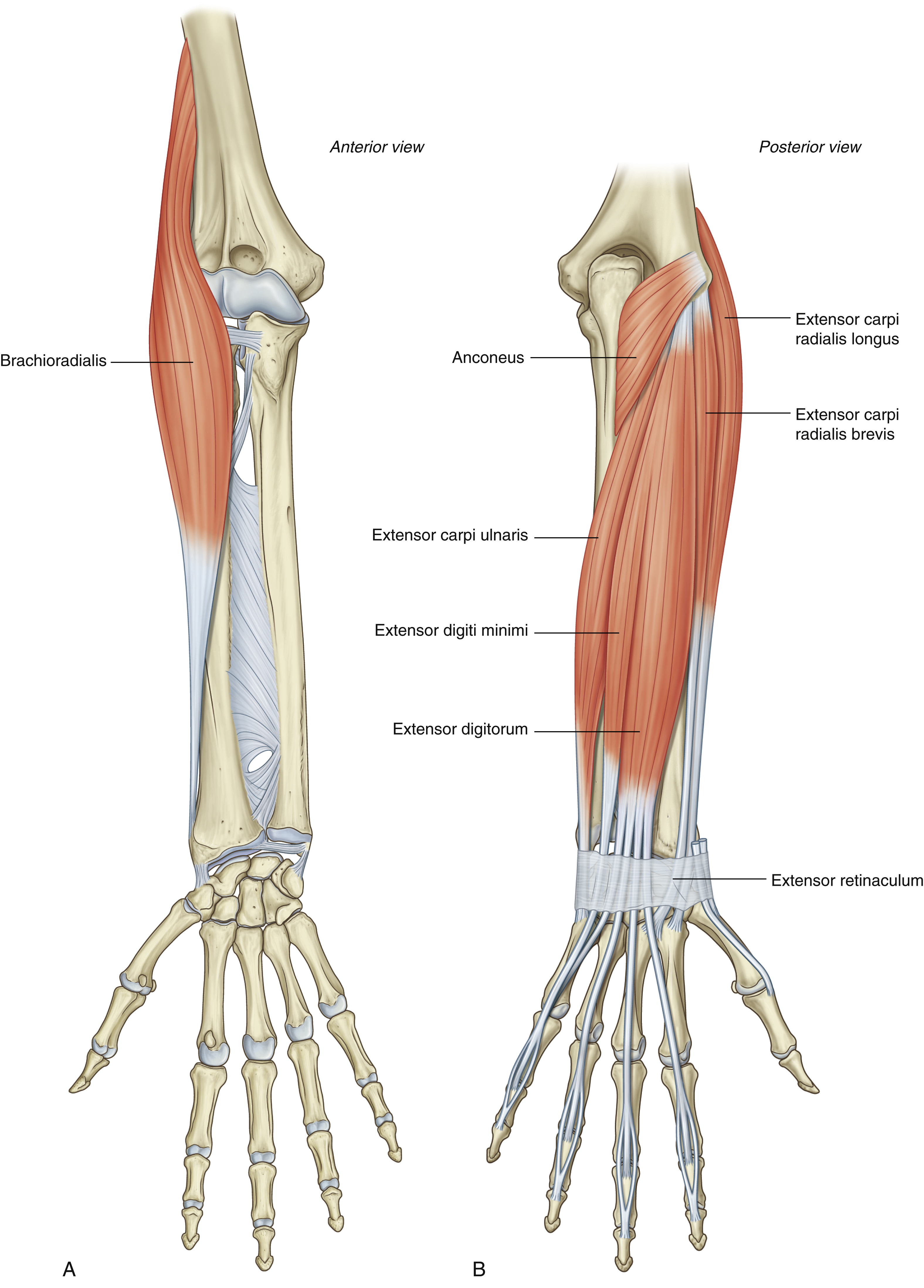
Brachioradialis: origin
Proximal part of lateral supraepicondylar ridge of humerus and adjacent intermuscular septum
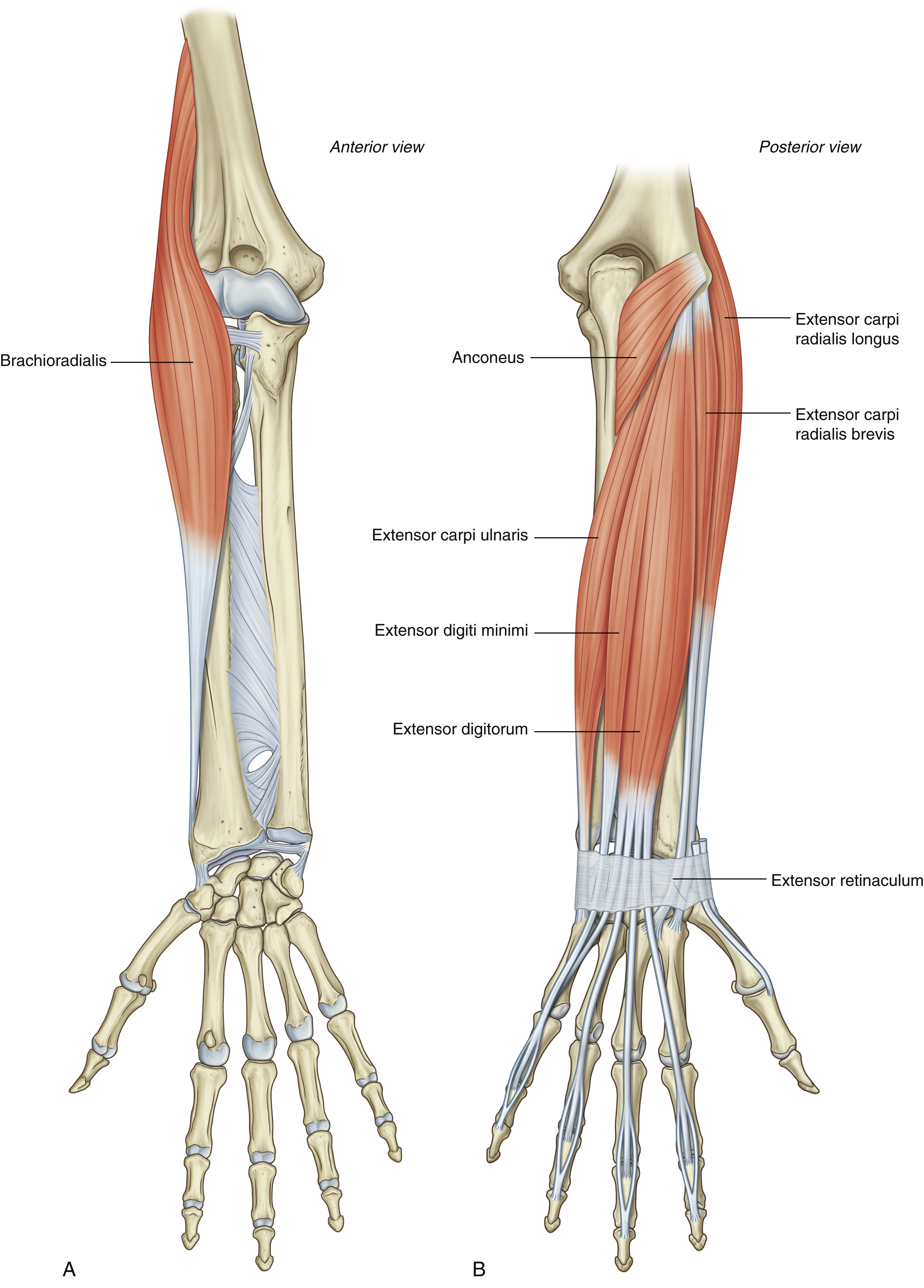
Brachioradialis: insertion
Lateral surface of distal end of radius
Brachioradialis: action
Accessory flexor of elbow joint when forearm is midpronated
Brachioradialis: innervation
Radial nerve (C5, C6 ) before division into superficial and deep branches

Triceps brachii: origin
Long head—infraglenoid tubercle of scapula; medial head—posterior surface of humerus; lateral head—posterior surface of humerus
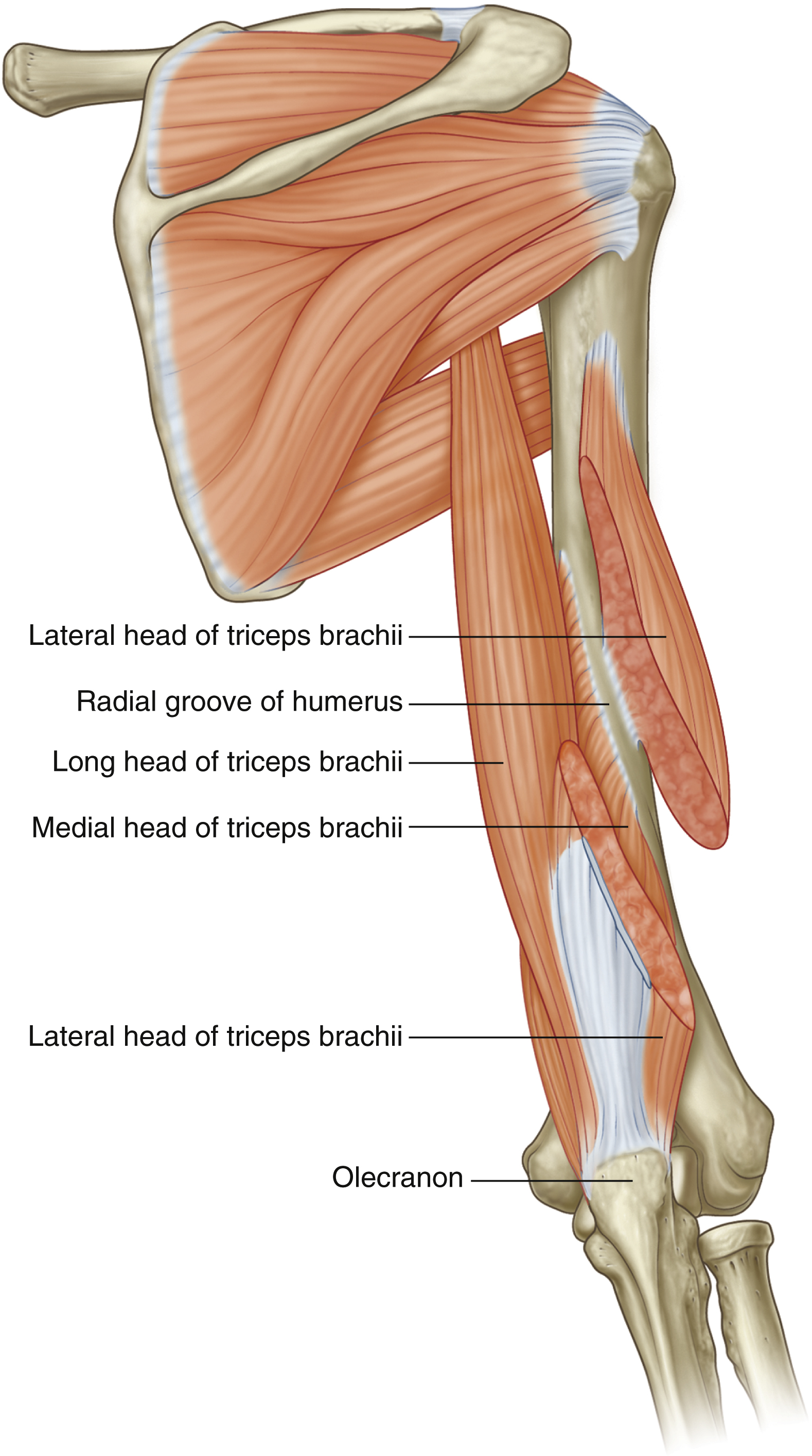
Triceps brachii: insertion
Olecranon
Triceps brachii: action
Extension of the forearm at the elbow joint; long head can also extend and adduct the arm at the shoulder joint
Triceps brachii: innervation
Radial nerve (C6, C7 , C8)

Pronator quadratus: origin
Linear ridge on distal anterior surface of ulna

Pronator quadratus: insertion
Distal anterior surface of radius
Pronator quadratus: action
Pronation
Pronator quadratus: innervation
Median nerve (anterior interosseous nerve) (C7, C8 )
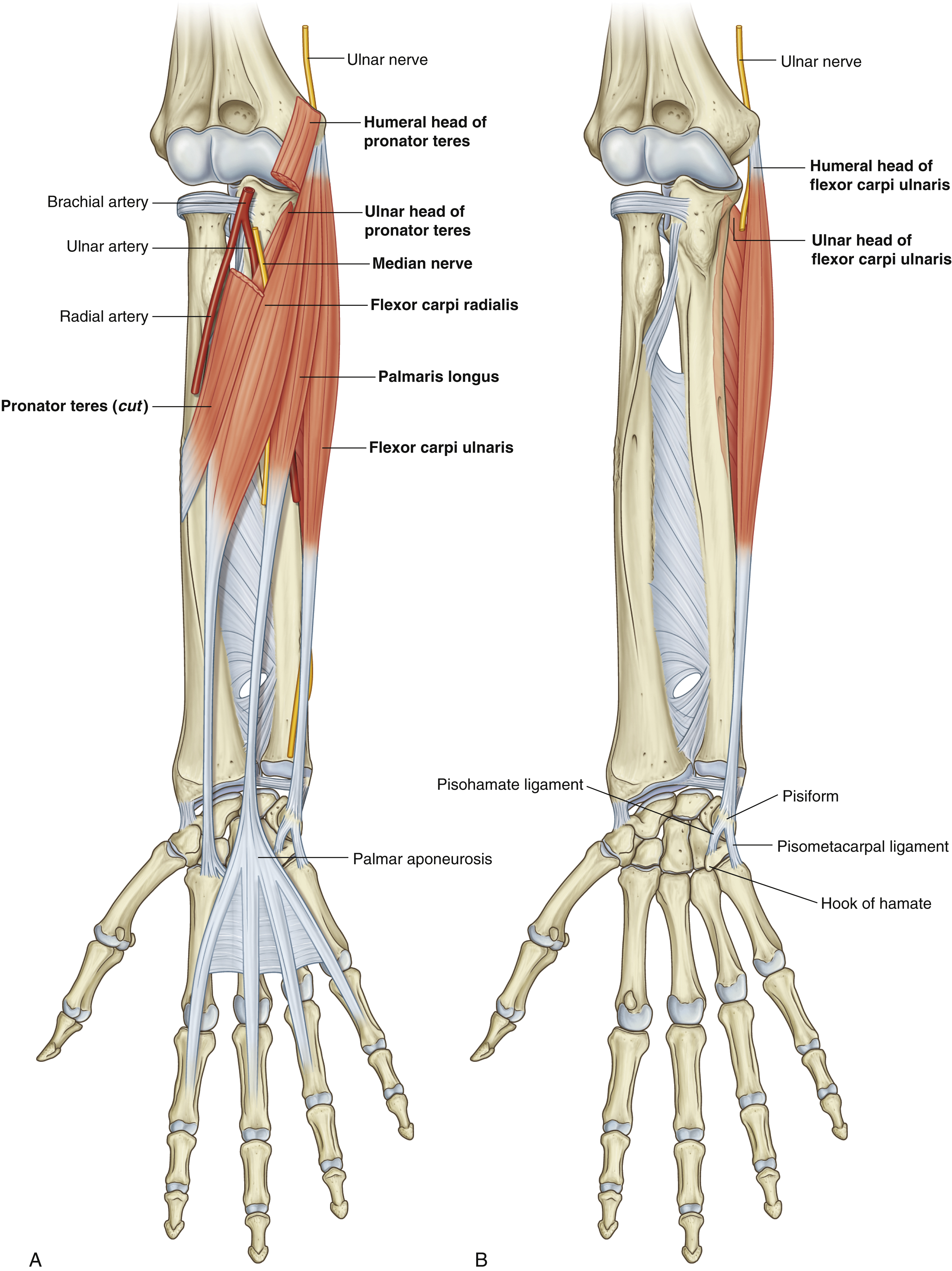
Pronator teres: origin
Humeral head—medial epicondyle and adjacent supra-epicondylar ridge; ulnar head—medial side of coronoid process
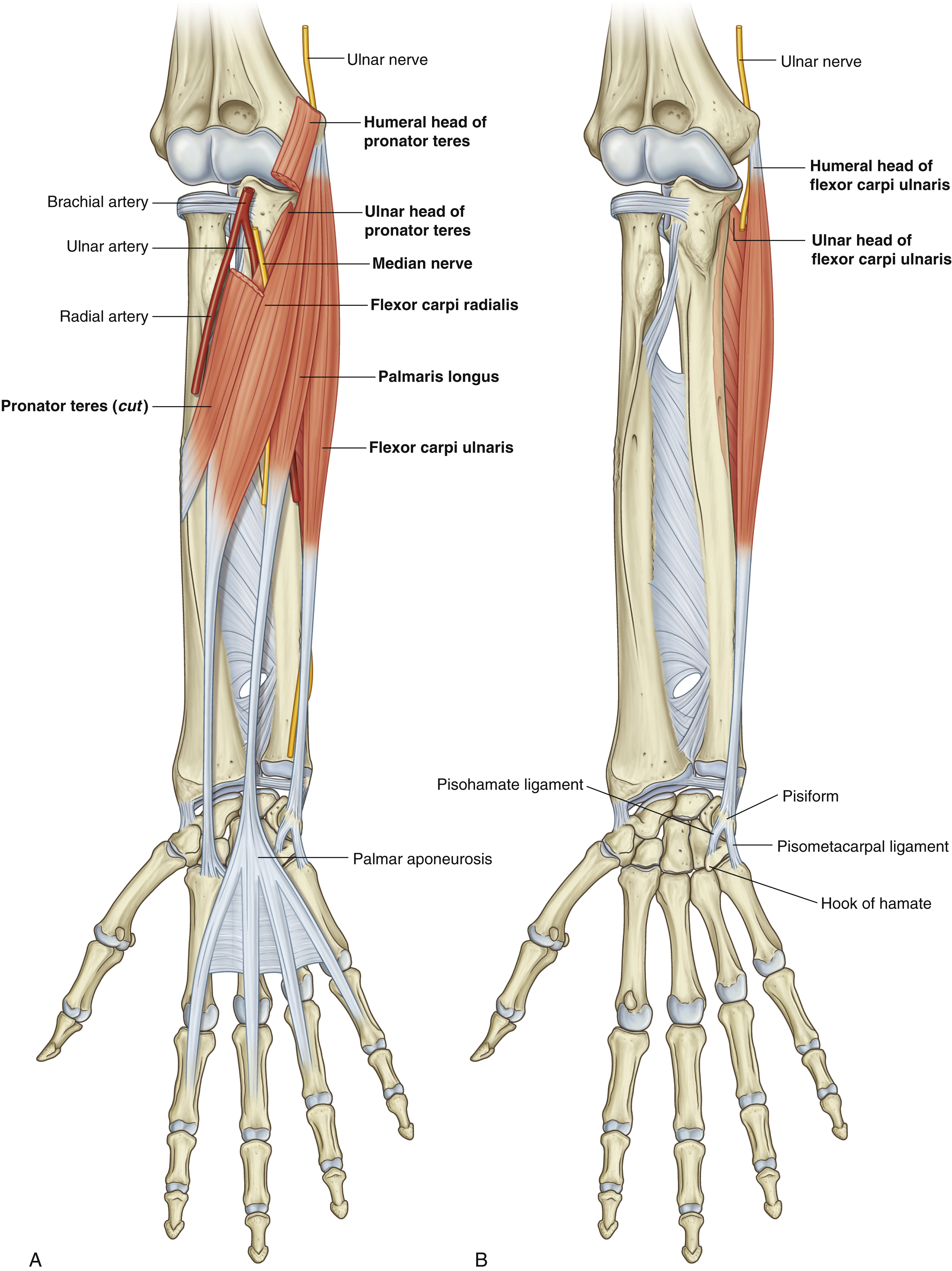
Pronator teres: insertion
Roughening on lateral surface, midshaft, of radius
Pronator teres: action
Pronation
Pronator teres: innervation
Median nerve (C6, C7 )
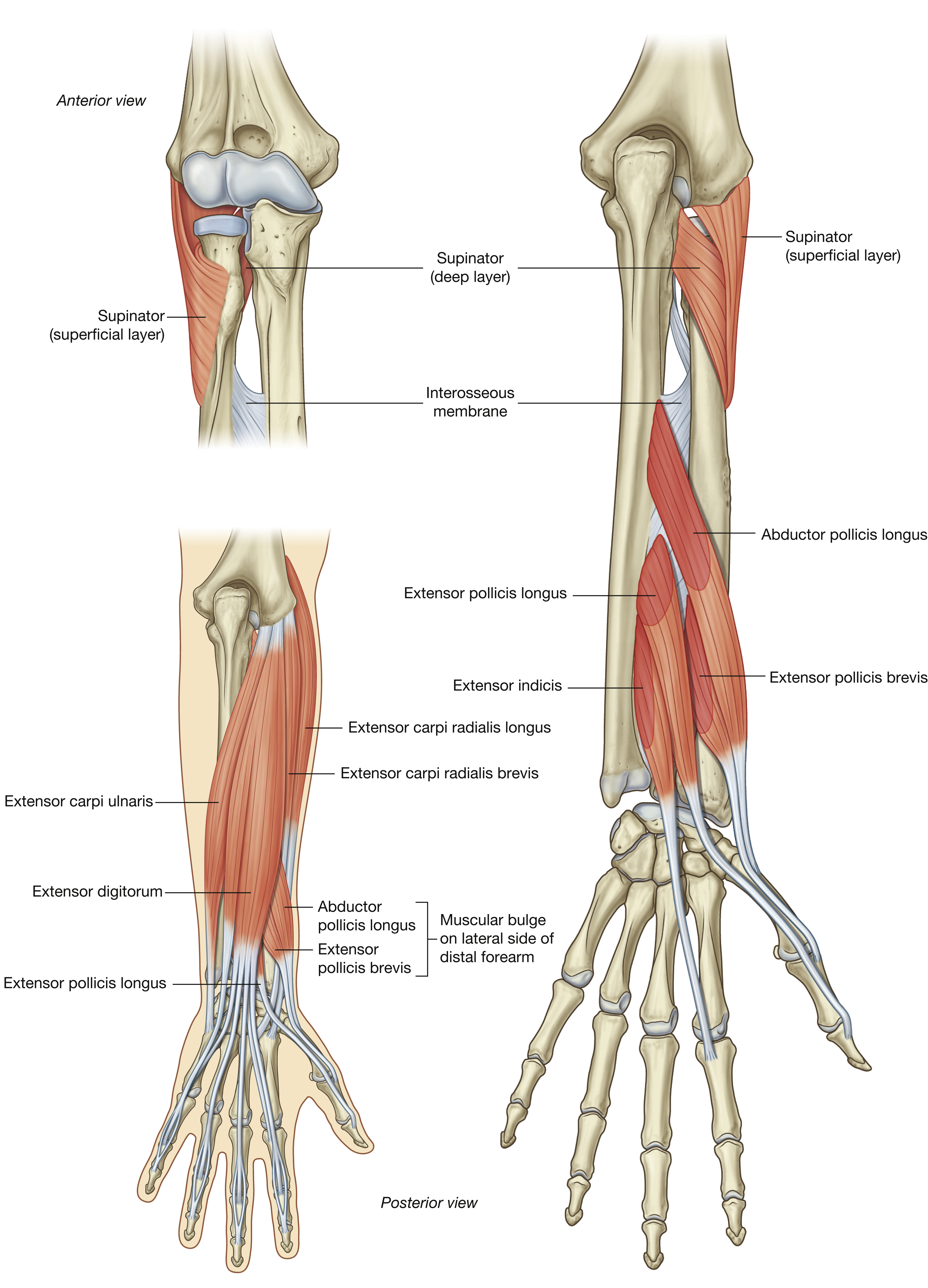
Supinator: origin
Superficial layer—lateral epicondyle of humerus, radial collateral and anular ligaments; deep layer—supinator crest of the ulna
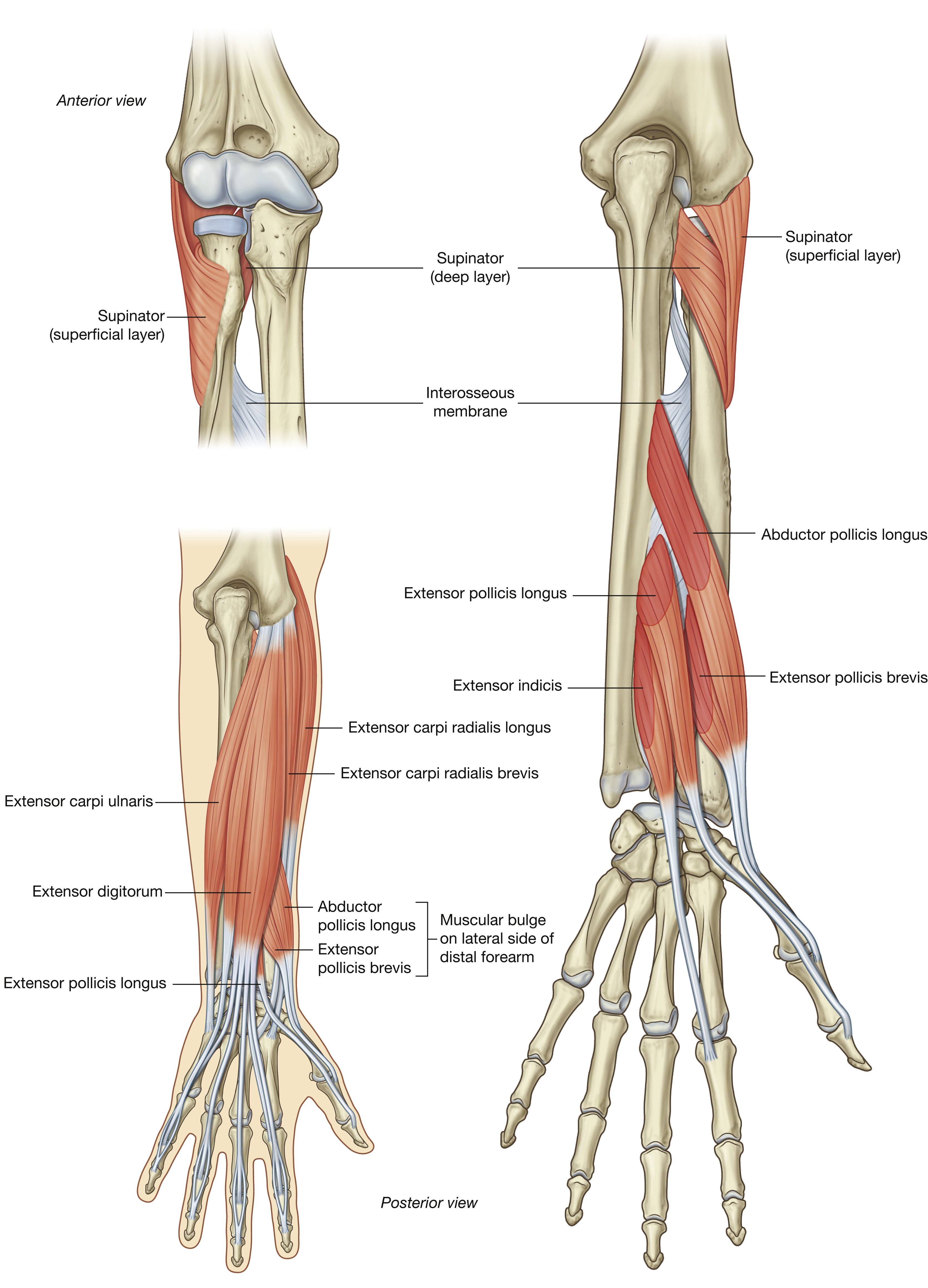
Supinator: insertion
Lateral surface of radius superior to the anterior oblique line
Supinator: action
Supination
Supinator: innervation
Posterior interosseous nerve ( C6 , C7)
Flexors of the hand and wrist: origin
Medial epicondyle of humerus
Flexors of the hand and wrist: insertion
base of metacarpals
Flexors of the hand and wrist: action
flex and abduct wrist
Flexors of the hand and wrist: innervation
median nerve
Extensors of the hand and wrist: origin
Lateral epicondyle of humerus
Extensors of the hand and wrist: insertion
Dorsal surface of base of metacarpals
Extensors of the hand and wrist: action
extend and abduct wrist
Extensors of the hand and wrist: innervation
radial nerve
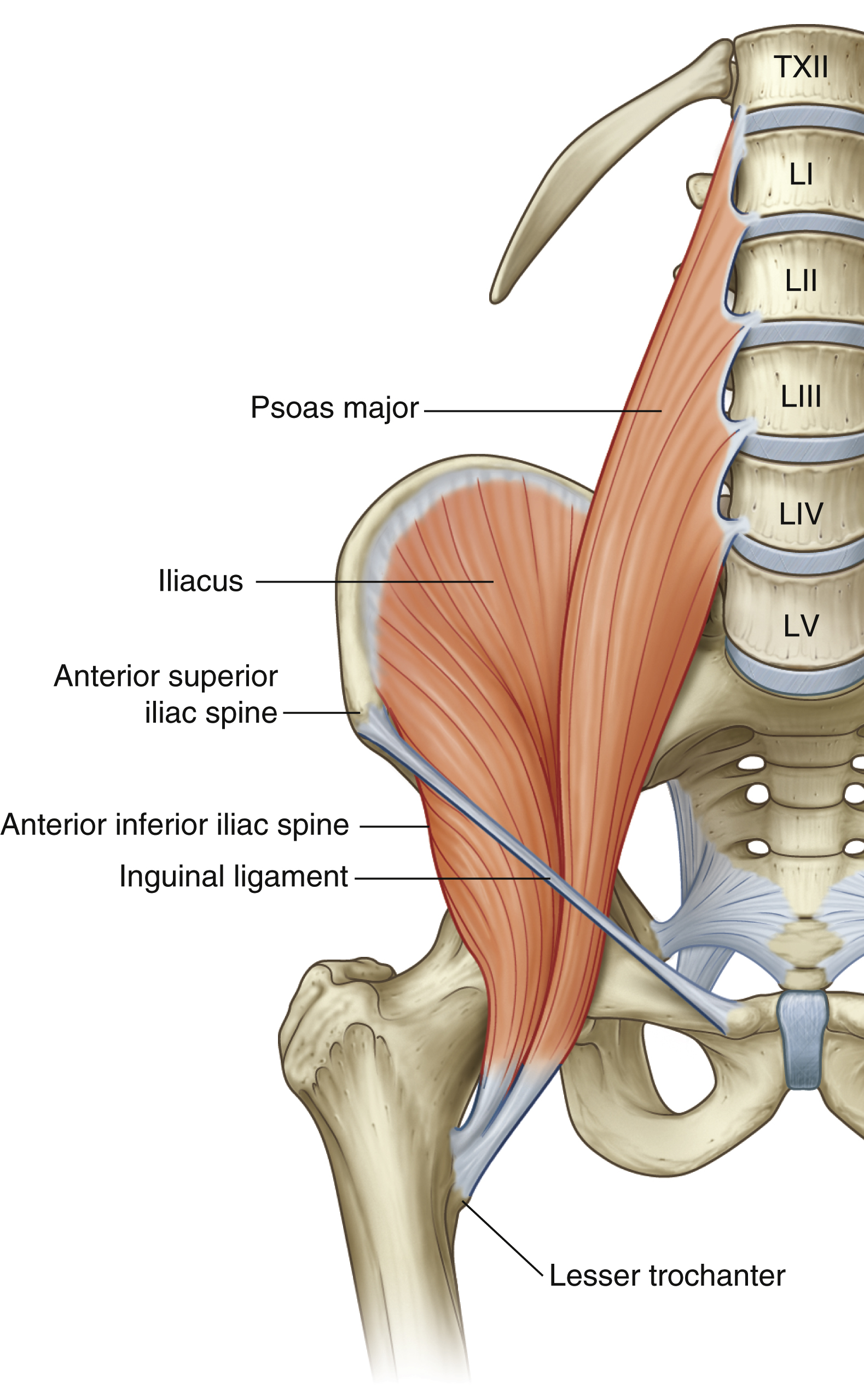
Iliopsoas: origin
Posterior abdominal wall (lumbar transverse processes, intervertebral discs, and adjacent bodies from TXII to LV and tendinous arches between these points, iliac fossa)

Iliopsoas: insertion
Lesser trochanter of femur
Iliopsoas: action
Flexes the thigh at the hip joint
Iliopsoas: innervation
Anterior rami ( L1, L2 , L3); Femoral nerve (L2, L3)
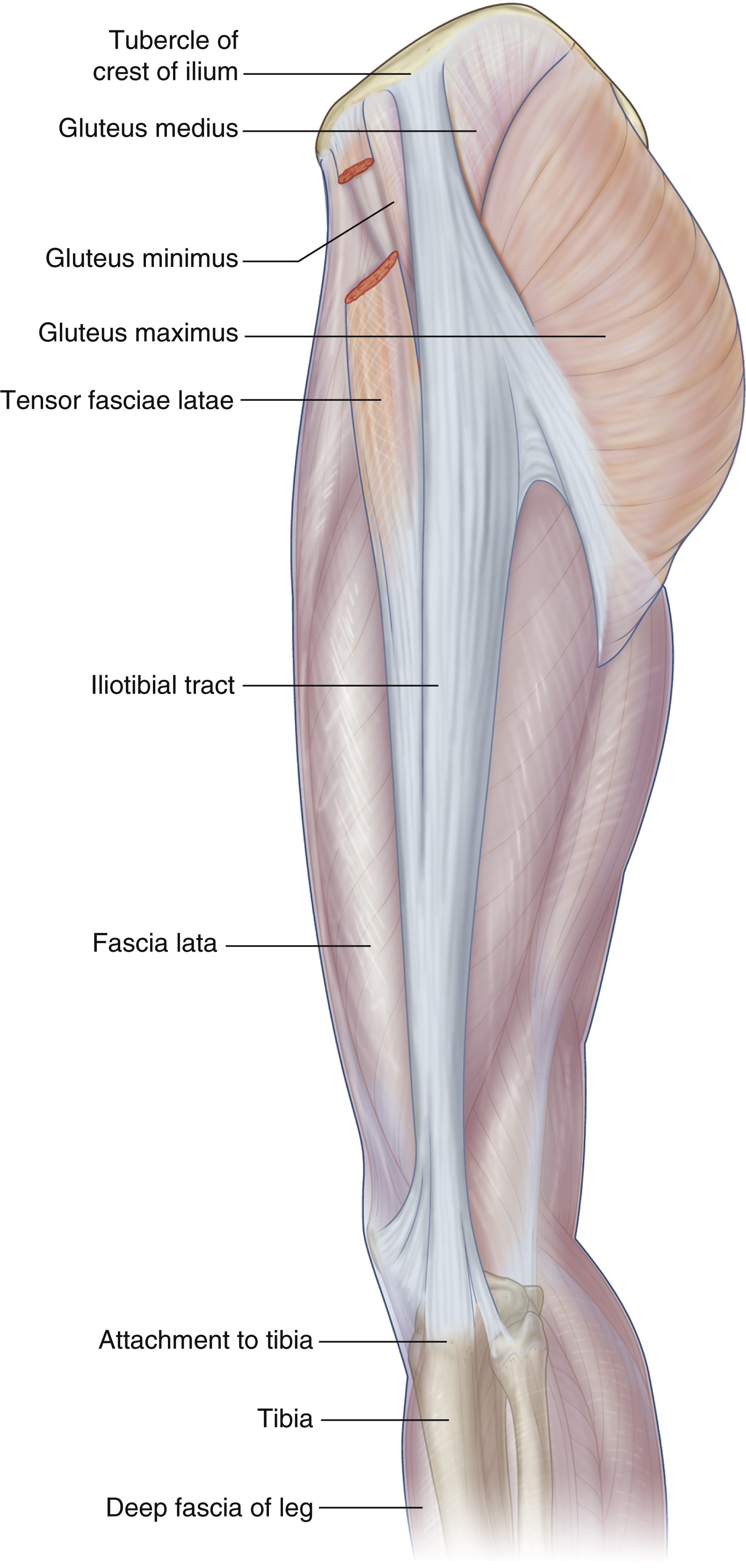
Tensor fascia latae: origin
Lateral aspect of crest of ilium between anterior superior iliac spine and tubercle of the crest
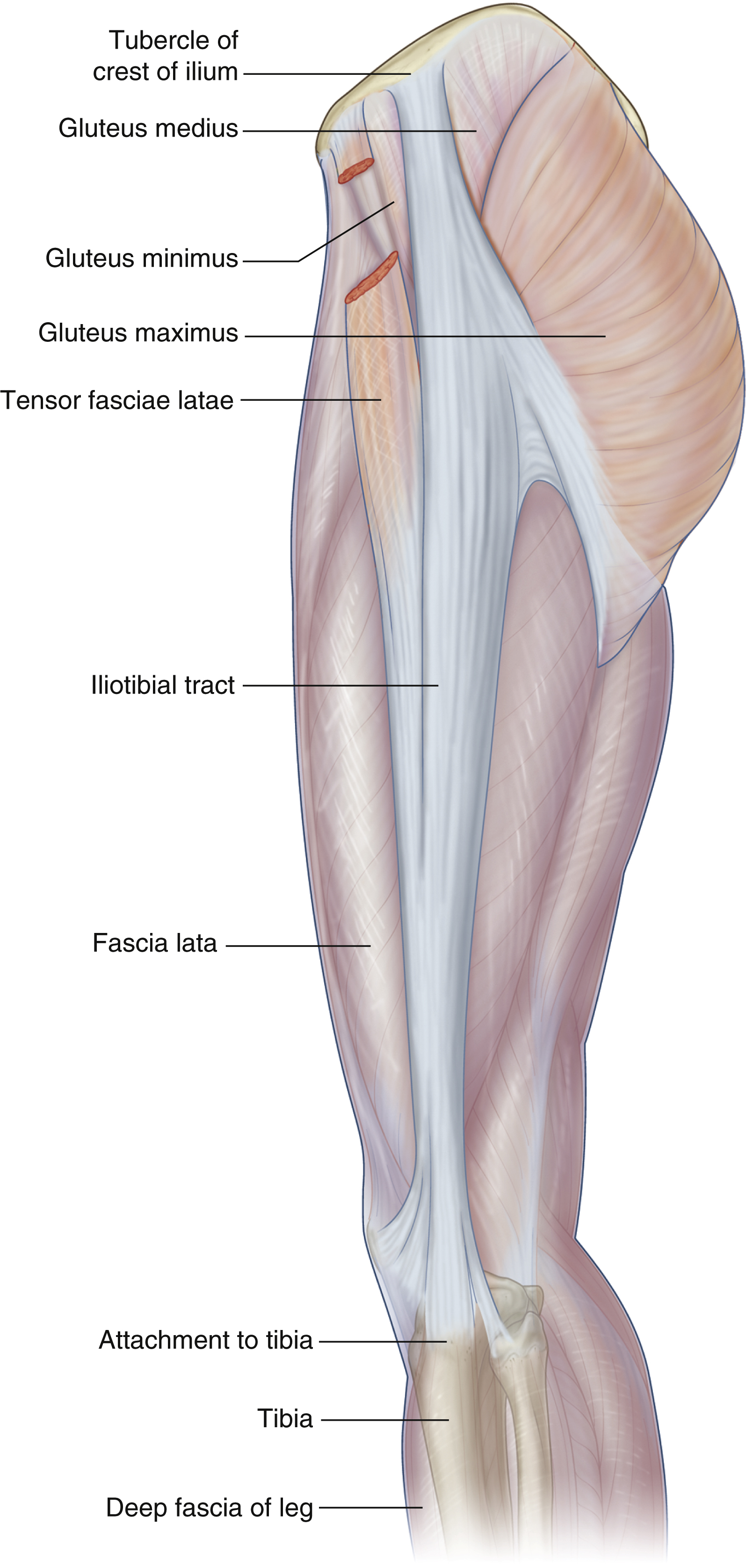
Tensor fascia latae: insertion
Iliotibial tract of fascia lata
Tensor fascia latae: action
Stabilizes the knee in extension
Tensor fascia latae: innervation
Superior gluteal nerve ( L4, L5 , S1)